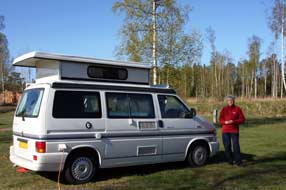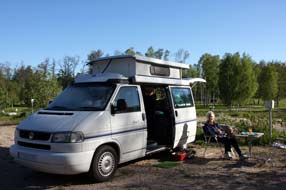|
 CAMPING
IN FINLAND 2015 - Åland Islands and Turku Archipelago: CAMPING
IN FINLAND 2015 - Åland Islands and Turku Archipelago:
The journey out to Finland: it's
exactly 1000 miles from Hook of the Holland ferry port near Rotterdam across
Holland, Northern Germany, Sjæland in Denmark to Copenhagen, over the Öresund Bridge to
Sweden, across the breadth of Sweden to Stockholm, and finally to the tiny port
of Kapellskär for the ferry to the Åland Islands. The loss of the one remaining
North Sea ferry-link to Scandinavia meant that the journey out to Finland now
took 4 days with the long continental drive, and an extra ferry from Puttgarden
north of Lübeck to Rødby in Southern Denmark;
map of our outward journey
 The crossing of the magnificent engineering
structure of the Öresund
Bridge (see left), though expensive at €47, never ceases to impress (Photo 1 - Crossing the Öresund Bridge), and we camped that
evening at Lomma on the Swedish shore with the sun setting across Öresund. The
following morning was warm and sunny with the cuckoo singing heartily, and we
were able to sit outside for breakfast looking along the length of the Öresund to the distant
view of the Bridge (Photo
2 - Breakfast by the Öresund at Lomma). The largely traffic-free A4 motorway, passing through hilly
wooded terrain with the light green of birches newly in leaf contrasting with dark
pines, brought us to Jonköping and the small town of Gränne for a night's
staging camp on the shore of the huge Lake Vätten (Photo
3 - Motorway to Stockholm). The second day of
trans-Sweden driving took us past Linköping, home of SAAB industries whose
aircraft are displayed alongside the motorway. A provisions stop at the Nyköping
ICA supermarket showed what a land of plenty Sweden truly is. In contrast with
the relaxing drive across Sweden, passing through the traffic-congested
Stockholm conurbation was the usual nightmarish experience and, grateful for the
reassuring precision of satnav guidance, we finally emerged on the NE side of the
city for the final section of A18 out to Kapellskär, and a night's camp by the
ferry port at Kapellskärs Camping. The peaceful setting amid pine and birch
woods is truly delightful, and with the air filled with birdsong and ground
covered with spring flowers
(Photo
4 - Kapellskärs Camping), the weariness of 4 solid days of driving faded from
recollection. Our 2015 venture had truly begun. The crossing of the magnificent engineering
structure of the Öresund
Bridge (see left), though expensive at €47, never ceases to impress (Photo 1 - Crossing the Öresund Bridge), and we camped that
evening at Lomma on the Swedish shore with the sun setting across Öresund. The
following morning was warm and sunny with the cuckoo singing heartily, and we
were able to sit outside for breakfast looking along the length of the Öresund to the distant
view of the Bridge (Photo
2 - Breakfast by the Öresund at Lomma). The largely traffic-free A4 motorway, passing through hilly
wooded terrain with the light green of birches newly in leaf contrasting with dark
pines, brought us to Jonköping and the small town of Gränne for a night's
staging camp on the shore of the huge Lake Vätten (Photo
3 - Motorway to Stockholm). The second day of
trans-Sweden driving took us past Linköping, home of SAAB industries whose
aircraft are displayed alongside the motorway. A provisions stop at the Nyköping
ICA supermarket showed what a land of plenty Sweden truly is. In contrast with
the relaxing drive across Sweden, passing through the traffic-congested
Stockholm conurbation was the usual nightmarish experience and, grateful for the
reassuring precision of satnav guidance, we finally emerged on the NE side of the
city for the final section of A18 out to Kapellskär, and a night's camp by the
ferry port at Kapellskärs Camping. The peaceful setting amid pine and birch
woods is truly delightful, and with the air filled with birdsong and ground
covered with spring flowers
(Photo
4 - Kapellskärs Camping), the weariness of 4 solid days of driving faded from
recollection. Our 2015 venture had truly begun.
|
Click on the 2 highlighted areas of map
for
details of
Åland Islands and Turku Archipelago |
 |
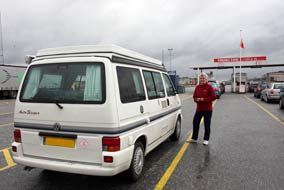 Ferry to the Åland
Islands: early the following
morning with a leaden sky, we joined the queue of vehicles down at the
dock for the 9-30 Viking Line ferry sailing for Mariehamn in the Åland Islands
midway across the Bothnian Gulf between Sweden and Finland (see left).
From M/S Rosella's aft deck, we took our departing photos as the ferry
pulled away from the Swedish mainland,
with the Åland flag gusting in the stiff breeze
(Photo
5 - Departing Kapellskär), and settled into the
ferry's lounge for the 2 hour crossing, advancing our watches a further hour for
Finnish time. The ferry threaded its way perilously closely through the
labyrinth of islets that make up the Swedish archipelago, with the sea a sullen
grey and the distant skerries stretching out to the horizon totally obscured by
misty rain cloud. In pouring rain, we drove ashore at Mariehamn, the main town
of the Åland Islands, pausing at the
Tourist Information Centre (TIC) in Storgatan where the helpful staff dealt with our
practical enquiries with customarily helpful efficiency, the most important
question being the location of a mobile phone shop to buy a Finnish Sonera pay-as-you-go SIM card. With the rain still pouring, we found Mi-data where our
phone needs were all soon sorted, and we headed out to Spar-Hallen supermarket in
the town northern outskirts, recalled from our 2012 visit, to stock up with
provisions. With all the practical issues dealt with, we could now head
out to Eckerö and our first campsite Söderhagen Camping. Click here for the
political and cultural background of Åland
from our 2012 visit. Ferry to the Åland
Islands: early the following
morning with a leaden sky, we joined the queue of vehicles down at the
dock for the 9-30 Viking Line ferry sailing for Mariehamn in the Åland Islands
midway across the Bothnian Gulf between Sweden and Finland (see left).
From M/S Rosella's aft deck, we took our departing photos as the ferry
pulled away from the Swedish mainland,
with the Åland flag gusting in the stiff breeze
(Photo
5 - Departing Kapellskär), and settled into the
ferry's lounge for the 2 hour crossing, advancing our watches a further hour for
Finnish time. The ferry threaded its way perilously closely through the
labyrinth of islets that make up the Swedish archipelago, with the sea a sullen
grey and the distant skerries stretching out to the horizon totally obscured by
misty rain cloud. In pouring rain, we drove ashore at Mariehamn, the main town
of the Åland Islands, pausing at the
Tourist Information Centre (TIC) in Storgatan where the helpful staff dealt with our
practical enquiries with customarily helpful efficiency, the most important
question being the location of a mobile phone shop to buy a Finnish Sonera pay-as-you-go SIM card. With the rain still pouring, we found Mi-data where our
phone needs were all soon sorted, and we headed out to Spar-Hallen supermarket in
the town northern outskirts, recalled from our 2012 visit, to stock up with
provisions. With all the practical issues dealt with, we could now head
out to Eckerö and our first campsite Söderhagen Camping. Click here for the
political and cultural background of Åland
from our 2012 visit.
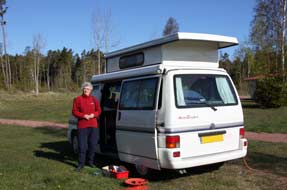 Söderhagen Camping in Eckerö: in
the pouring rain, Åland's landscape looked dismally sodden as we drove westwards
across Hammarland island and crossed to Eckerö to turn off to the hamlet of
Torp. We had first stayed at Söderhagen Camping in 2012 and had kept in touch
with the owners Sven and Susanna Eklund since then; as we arrived at the
campsite, the familiar jovial figure of Sven drew up in Söderhagen Camping in Eckerö: in
the pouring rain, Åland's landscape looked dismally sodden as we drove westwards
across Hammarland island and crossed to Eckerö to turn off to the hamlet of
Torp. We had first stayed at Söderhagen Camping in 2012 and had kept in touch
with the owners Sven and Susanna Eklund since then; as we arrived at the
campsite, the familiar jovial figure of Sven drew up in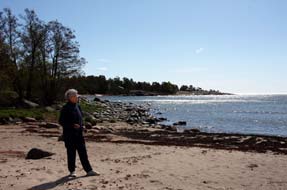 his pick-up and greeted
us like long-lost friends. We settled onto the formerly forested hillock
overlooking the Torpfjärden inlet of the sea where by sheer hard graft, Sven had
created the now cleared and levelled camping area (see left). How good it was to be back;
we could relax with a feeling that our outward journeying was now complete.
The rain had eased but it was still bleakly cold as Sven told us of his work of
the last 3 years in clearing further forest to enlarge the camping; thanks
to his efforts in draining the land, there was no trace of water-logging despite
12 hours of continuous rain.
his pick-up and greeted
us like long-lost friends. We settled onto the formerly forested hillock
overlooking the Torpfjärden inlet of the sea where by sheer hard graft, Sven had
created the now cleared and levelled camping area (see left). How good it was to be back;
we could relax with a feeling that our outward journeying was now complete.
The rain had eased but it was still bleakly cold as Sven told us of his work of
the last 3 years in clearing further forest to enlarge the camping; thanks
to his efforts in draining the land, there was no trace of water-logging despite
12 hours of continuous rain.
A relaxing day around Eckerö: the
rain clouds had finally dissipated overnight and the following morning the sky
was clear, though the wind was still chill. The wind nearly always blows on the Ålands,
and the islanders have a saying: 'Don't curse the wind, learn to sail'. We were
able to enjoy the peace of Söderhagen's wonderful woodland setting and from the
flat hilltop could look out across the fjord with the bright morning sun
sparkling on the water
(Photo
6 - Söderhagen Camping); a cuckoo could be heard singing
 in the
surrounding pine and birch woods, and a redstart perched on a nearby post. Today
we should enjoy a relaxing day around Eckerö. Along the gravel lane we parked
down at Degersand to walk through to the deserted wild beach which enclosed this
beautiful bay
(Photo
7 - Degersand wild beach). Here we sat on the shore side rocks drinking
in the peace of this magnificent setting with the sun sparkling across the water
and terns flitting around diving for fish (see above right). The faming in the
surrounding pine and birch woods, and a redstart perched on a nearby post. Today
we should enjoy a relaxing day around Eckerö. Along the gravel lane we parked
down at Degersand to walk through to the deserted wild beach which enclosed this
beautiful bay
(Photo
7 - Degersand wild beach). Here we sat on the shore side rocks drinking
in the peace of this magnificent setting with the sun sparkling across the water
and terns flitting around diving for fish (see above right). The faming
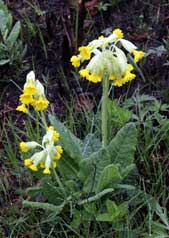 hamlet of Torp is
quintessentially Åland with its windmill
(Photo
8 - Åland post-windmill), household post-boxes on the fence by the
village bus stop (see left), and beautiful cowslips, Åland's national flower,
growing in profusion by the road-side (see right). Åland had been
incorporated into Tsarist Russia along with the rest of Finland in 1809, and
at Storby in the far west of Eckerö, the grandiose Post House was built to meet
the post-boat from Stockholm at the start of the Royal Post Road to St Petersburg, and
to impress visitors to this western outpost of the Imperial Russian Empire
(Photo
9 - Storby Post House). Westward along the main Route 1, like all of Åland
remarkably free of traffic, we turned off at Kyrkoby to visit the Church of St
Lars. The red granite Eckerö Kyrka with its sturdy tower was built in the 13th
century as a place of worship for seafarers
(Photo
10 - Eckerö Kyrka). Being Ascension
Day, the church was open and although the church's structure preserves much of
its medieval origins, the internal decoration dates mainly from the 18~20th
centuries. Continuing westwards, we crossed to Hammarland to visit Sankta
Catherina Kyrka at Kattby (Photo
11 - Kattby Church). Åland was late to be Christianised, and many churches
were built alongside a pagan burial-ground as at Kattby. It had been a
wonderfully refreshing day exploring the western island of Eckerö in sunshine,
but the forecast for tomorrow was for a return to cold, wet weather and we were
looking forward to a day in camp at Söderhagen Camping. hamlet of Torp is
quintessentially Åland with its windmill
(Photo
8 - Åland post-windmill), household post-boxes on the fence by the
village bus stop (see left), and beautiful cowslips, Åland's national flower,
growing in profusion by the road-side (see right). Åland had been
incorporated into Tsarist Russia along with the rest of Finland in 1809, and
at Storby in the far west of Eckerö, the grandiose Post House was built to meet
the post-boat from Stockholm at the start of the Royal Post Road to St Petersburg, and
to impress visitors to this western outpost of the Imperial Russian Empire
(Photo
9 - Storby Post House). Westward along the main Route 1, like all of Åland
remarkably free of traffic, we turned off at Kyrkoby to visit the Church of St
Lars. The red granite Eckerö Kyrka with its sturdy tower was built in the 13th
century as a place of worship for seafarers
(Photo
10 - Eckerö Kyrka). Being Ascension
Day, the church was open and although the church's structure preserves much of
its medieval origins, the internal decoration dates mainly from the 18~20th
centuries. Continuing westwards, we crossed to Hammarland to visit Sankta
Catherina Kyrka at Kattby (Photo
11 - Kattby Church). Åland was late to be Christianised, and many churches
were built alongside a pagan burial-ground as at Kattby. It had been a
wonderfully refreshing day exploring the western island of Eckerö in sunshine,
but the forecast for tomorrow was for a return to cold, wet weather and we were
looking forward to a day in camp at Söderhagen Camping.
A bitterly cold and wet day in camp:
the change in weather happened overnight with increased wind from the north,
pouring rain and a severe drop in temperature. By good chance, we had not only
pitched the camper in a level spot but in perfect alignment with the changed
wind direction which was now driving the rain onto the front. But despite
plugging vents to keep out chill draughts, such was the wind chill that the
fan-heater struggled to maintain a comfortable temperature
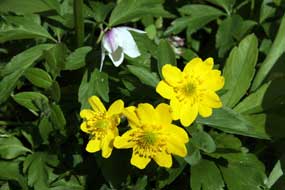 and we were forced to
wear Arctic layers for warmth. The driving rain and miserably cold NW wind
continued unabated all day; this was supposed to be the mild south, and in
comparison our past experience made being north of the Arctic Circle seem
positively tropical! and we were forced to
wear Arctic layers for warmth. The driving rain and miserably cold NW wind
continued unabated all day; this was supposed to be the mild south, and in
comparison our past experience made being north of the Arctic Circle seem
positively tropical!
The Ramsholmen Wooded Meadow Nature Walk:
by some meteorological miracle, all of the rain cloud of cleared overnight,
and we woke to a clear sky and - wonder of wonders - clear, warm sun. But the
North-westerly was still blowing albeit less chill than yesterday. Never mind,
it was so good to feel the restorative warmth of the sun, and the clear sky was
a wonderful morale booster. We settled up with Sven for our stay at Söderhagen,
bade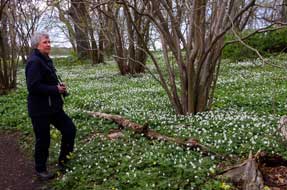 him farewell for perhaps another couple of years, and drove westwards back
towards the outskirts of Mariehamn, where we turned off for the Ramsholmen Nature
Walk, one of the excellent series of Åland walks published by the Mariehamn TIC.
The Ramsholmen peninsula is one of the few surviving areas of wooded meadows in Åland
from which the mown hay and pollarded foliage of ash trees was once used as
winter feed for cattle. The walk started well when we spotted a Green Sandpiper
stalking among the reeds of a water meadow
(Photo
12 - Green Sandpiper). Ramsholmen Wooded Meadow was as glorious as ever with masses of White
and Yellow Wood Anemones (see above left), and clumps of perky Cowslips all growing among the
Wild Garlic still in bud under the many-branching pollarded ash and hazel trees (Photo
13 - Ramsholmen wooded meadow). We made slow progress around the path circuit since every step brought
another stop to photograph the magnificent floral display (see right). The air was rich with
the garlicky smell of the Wild Garlic (Ramson) which grows in such profusion and
gives the meadow its name of Ramsholmen. Rounding the tip of the peninsula, we
found a lovely colony of Early Purple Orchids (Orchis mascula), and wild
Lily of the Valley still tightly in bud. The meadow is clearly a popular weekend
walk and picnic spot and back at the car park we chatted with a couple of local Ålanders
who expressed amazement at visitors from England; however did you discover our
islands? they asked. him farewell for perhaps another couple of years, and drove westwards back
towards the outskirts of Mariehamn, where we turned off for the Ramsholmen Nature
Walk, one of the excellent series of Åland walks published by the Mariehamn TIC.
The Ramsholmen peninsula is one of the few surviving areas of wooded meadows in Åland
from which the mown hay and pollarded foliage of ash trees was once used as
winter feed for cattle. The walk started well when we spotted a Green Sandpiper
stalking among the reeds of a water meadow
(Photo
12 - Green Sandpiper). Ramsholmen Wooded Meadow was as glorious as ever with masses of White
and Yellow Wood Anemones (see above left), and clumps of perky Cowslips all growing among the
Wild Garlic still in bud under the many-branching pollarded ash and hazel trees (Photo
13 - Ramsholmen wooded meadow). We made slow progress around the path circuit since every step brought
another stop to photograph the magnificent floral display (see right). The air was rich with
the garlicky smell of the Wild Garlic (Ramson) which grows in such profusion and
gives the meadow its name of Ramsholmen. Rounding the tip of the peninsula, we
found a lovely colony of Early Purple Orchids (Orchis mascula), and wild
Lily of the Valley still tightly in bud. The meadow is clearly a popular weekend
walk and picnic spot and back at the car park we chatted with a couple of local Ålanders
who expressed amazement at visitors from England; however did you discover our
islands? they asked.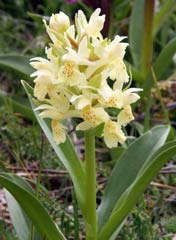
Nåtö Nature Walk: south of
Mariehamn, we crossed the causeways linking across to the extended islets to
find the Nåtö Nature Walk, another of the TIC's series of walks. The rocky slabs
at the start of the way-marked route through shore-side wooded meadows were a
paradise garden of bushy ruby-red and lemon yellow Elderflower Orchids (Dactyloriza
sambucina), and we were soon down on hands and knees photographing these
elegantly distinguished wild orchids (see left) (Photo
14 - Elderflower Orchids) called in Swedish (the predominant language
spoken in the Ålands) Adam and Eve Orchids since colonies of red and yellow flowers
generally grow side by side. We followed the path through the flower filled meadows
down to the coast-line where terns flitted and dived around the bay and swallows
soared over the shore. In today's sunny weather, the two nature walks had given
us a truly botanical feast-day, but after shopping for provisions in Mariehamn,
we now had an hour's drive to reach tonight's campsite on the outlying island of
Vårdö on the NW Ålands archipelago. Before leaving we telephoned Sandösunds
Camping to confirm they were open. The owner responded helpfully: he was just
off out for an evening's fishing but told us to settle in and he would be back
later.
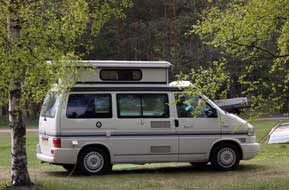 A hospitable welcome at Sandösunds Camping on
Vårdö Island:
heading north to Godby, we turned across Sund and crossed the bridge to Prästö
Island from where a free-of-charge chain ferry conveys vehicles over the narrow
sound to the next island in the chain Töftö; over one final long bridge and we
had at last reached Vårdö and turned off along a dirt road to Sandösunds
Camping. First impressions were of water-logged ground after the rain of the
last few days, but with the evening now getting chill we eventually found an
open sunlit camping area beyond the dark shore-side pines and settled in (see
right). The
owner arrived back from his fishing trip, moored his boat at the nearby jetty,
welcomed us to the campsite and showed us the facilities some distance away up
at reception. The following morning, when we took our washing-up to the
well-equipped kitchen, we met the petite Russian lady who ran the campsite café;
this was Marina from St Petersburg, an emigrée from Putin's evil empire. She
chatted away in fluent but heavily accented English; clearly an educated lady,
she contrasted her former life and high standard of living as a musician during
Soviet days. Now retired however her A hospitable welcome at Sandösunds Camping on
Vårdö Island:
heading north to Godby, we turned across Sund and crossed the bridge to Prästö
Island from where a free-of-charge chain ferry conveys vehicles over the narrow
sound to the next island in the chain Töftö; over one final long bridge and we
had at last reached Vårdö and turned off along a dirt road to Sandösunds
Camping. First impressions were of water-logged ground after the rain of the
last few days, but with the evening now getting chill we eventually found an
open sunlit camping area beyond the dark shore-side pines and settled in (see
right). The
owner arrived back from his fishing trip, moored his boat at the nearby jetty,
welcomed us to the campsite and showed us the facilities some distance away up
at reception. The following morning, when we took our washing-up to the
well-equipped kitchen, we met the petite Russian lady who ran the campsite café;
this was Marina from St Petersburg, an emigrée from Putin's evil empire. She
chatted away in fluent but heavily accented English; clearly an educated lady,
she contrasted her former life and high standard of living as a musician during
Soviet days. Now retired however her
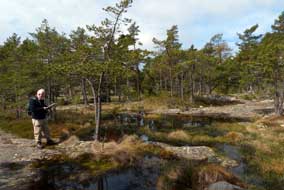 pension was almost worthless, but despite
this she relished living here in peaceful Åland. She also contrasted the
restriction on life and food shortages in former USSR with the freedom to travel
post-perestroika. She spoke lovingly about the early 1990s days of hope
under glasnost, and about the thrill of being able to drive for just 1 hour from
St Petersburg and to walk across the Estonian border at Narva to another country
where people were happy and streets clean in contrast with the dour life in the
run-down neighbouring Russian city of Ivangorod across the river. We recalled
our similar experience in the modern of Vyborg, formerly the Finnish city of
Viipuri. Our conversation with this charming lady was another of those memorable and enlightening encounters that enrich our travels. With the wind becoming
increasingly chill, we spent the day in camp writing and dealing with photos,
and watching the chaffinches and yellow hammers pecking around outside the
camper. Olof the campsite owner stopped by on his way to his boat and we asked him about local
walks on Vårdö; he recommended the 4km long Lövö Naturstig (Nature Walk).
loaned us a detailed map and gave us guidance on the route and way-marking. He
was an interesting and much-travelled man and we spoke at length with him on a
number of subjects. Despite first impressions, Sandösunds Camping very quickly
grew on us; at €16/night this unassuming, straightforward and welcoming campsite
with free wi-fi in the café was both a delightful place and exceptional value
(Photo
15 - Sandösunds Camping). pension was almost worthless, but despite
this she relished living here in peaceful Åland. She also contrasted the
restriction on life and food shortages in former USSR with the freedom to travel
post-perestroika. She spoke lovingly about the early 1990s days of hope
under glasnost, and about the thrill of being able to drive for just 1 hour from
St Petersburg and to walk across the Estonian border at Narva to another country
where people were happy and streets clean in contrast with the dour life in the
run-down neighbouring Russian city of Ivangorod across the river. We recalled
our similar experience in the modern of Vyborg, formerly the Finnish city of
Viipuri. Our conversation with this charming lady was another of those memorable and enlightening encounters that enrich our travels. With the wind becoming
increasingly chill, we spent the day in camp writing and dealing with photos,
and watching the chaffinches and yellow hammers pecking around outside the
camper. Olof the campsite owner stopped by on his way to his boat and we asked him about local
walks on Vårdö; he recommended the 4km long Lövö Naturstig (Nature Walk).
loaned us a detailed map and gave us guidance on the route and way-marking. He
was an interesting and much-travelled man and we spoke at length with him on a
number of subjects. Despite first impressions, Sandösunds Camping very quickly
grew on us; at €16/night this unassuming, straightforward and welcoming campsite
with free wi-fi in the café was both a delightful place and exceptional value
(Photo
15 - Sandösunds Camping).
 Lövö Naturstig (Nature Walk) on Vårdö:
our plan for the following day was to follow the Lövö Nature Walk, and although
the wind had eased, the sky was heavily overcast and air still chill. The
circular route started directly from Sandösunds Camping in pine woodland by some
boat houses, with delicate pink Bilberry flowers and early buds of Lingonberry
carpeting the forest floor. The path advanced over bare slabs of Åland red
granite, gaining height across the open wooded fell-side of Norrskogen with
cushions of lichen covering the rocks under the scattered pines (see above
left). By now the sun
had broken through giving a wonderfully clear light, and we revelled in the
peace and beauty of this magnificent wild terrain (Photo
16 - Lövö Nature Walk). The path was clearly way-marked with lines of
cairns indicating an almost clear pavement over the smooth slabbed granite outcrops, before re-entering forest cover with increased vegetation. We
paused for an early lunch among rowan trees and sweetly-scented wild Lily of the
Valley in early bud. The path led back towards Lövö village, emerging by a
post-windmill and celebratory midsummer pole which still bore last year's
decorations (see right). Lövö was the location of a peace conference between the
Tsarist Russian Empire and Kingdom of Sweden in 1718~19 during the Great Northern
War; some 1,200 delegates encamped here, indulging more in feasting than
securing a permanent peace. We turned off on the return leg along a farm track
which was lined with more floral delights: beautiful Wood Anemones and May
Lilies in early tight bud. A way-marked path wound through pine woods, the
forest floor covered with Bilberry and Wood Sorrel, and emerged eventually back
at Sandösunds Camping. Lövö Naturstig (Nature Walk) on Vårdö:
our plan for the following day was to follow the Lövö Nature Walk, and although
the wind had eased, the sky was heavily overcast and air still chill. The
circular route started directly from Sandösunds Camping in pine woodland by some
boat houses, with delicate pink Bilberry flowers and early buds of Lingonberry
carpeting the forest floor. The path advanced over bare slabs of Åland red
granite, gaining height across the open wooded fell-side of Norrskogen with
cushions of lichen covering the rocks under the scattered pines (see above
left). By now the sun
had broken through giving a wonderfully clear light, and we revelled in the
peace and beauty of this magnificent wild terrain (Photo
16 - Lövö Nature Walk). The path was clearly way-marked with lines of
cairns indicating an almost clear pavement over the smooth slabbed granite outcrops, before re-entering forest cover with increased vegetation. We
paused for an early lunch among rowan trees and sweetly-scented wild Lily of the
Valley in early bud. The path led back towards Lövö village, emerging by a
post-windmill and celebratory midsummer pole which still bore last year's
decorations (see right). Lövö was the location of a peace conference between the
Tsarist Russian Empire and Kingdom of Sweden in 1718~19 during the Great Northern
War; some 1,200 delegates encamped here, indulging more in feasting than
securing a permanent peace. We turned off on the return leg along a farm track
which was lined with more floral delights: beautiful Wood Anemones and May
Lilies in early tight bud. A way-marked path wound through pine woods, the
forest floor covered with Bilberry and Wood Sorrel, and emerged eventually back
at Sandösunds Camping.
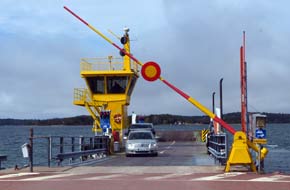 Ferry to the remote island of Simskäla: since it was only 2-30pm,
we had time this afternoon to investigate the elongated peninsula across Sandösund bridge connecting to
the northward extension of Sandö Island. At its northernmost tip, the lane
continued along a causeway stretching across to end at an islet from where a
chain-ferry bridged the 1.5km gap to the remote island of Simskäla (pronounced
Simshella), the northernmost of the main group of the Åland Islands (see
left). We
pulled over by the pedestrians' ferry shelter as 2 cars boarded the little ferry
which shuttles back and forth across the sound. Since the ferry was
free-of-charge as part of the islands' transport infrastructure, we decided to
take the
opportunity to cross to Simskäla. 10 minutes later the ferry returned and waited
for the bus from Vårdö to drop off a lone schoolboy who walked aboard; we
boarded along with one other car and the ferry chugged across the sound to dock
at Simskäla (Photo
17 - Ferry across to Simskäla). A taxi with 'school bus' head-board was
waiting to convey the schoolboy home on Simskäla island. What enviably wonderful
public services the Ålanders enjoy, compared with the miserably impoverished and
ever-declining state of UK society. We drove ashore and followed the winding
lane around Östra (East) Simskäla, crossing the narrow bridge over to Västra
(West) Simskäla.
Passing cottages and small farms, we returned to the ferry dock where the ferry
was waiting to return us across the sound to the northern tip of the Sandö
causeway. The seas around Simskäla were dotted with a myriad of scattered islets
and skerries, part of the 6,000 which make up the Ålands archipelago. Ferry to the remote island of Simskäla: since it was only 2-30pm,
we had time this afternoon to investigate the elongated peninsula across Sandösund bridge connecting to
the northward extension of Sandö Island. At its northernmost tip, the lane
continued along a causeway stretching across to end at an islet from where a
chain-ferry bridged the 1.5km gap to the remote island of Simskäla (pronounced
Simshella), the northernmost of the main group of the Åland Islands (see
left). We
pulled over by the pedestrians' ferry shelter as 2 cars boarded the little ferry
which shuttles back and forth across the sound. Since the ferry was
free-of-charge as part of the islands' transport infrastructure, we decided to
take the
opportunity to cross to Simskäla. 10 minutes later the ferry returned and waited
for the bus from Vårdö to drop off a lone schoolboy who walked aboard; we
boarded along with one other car and the ferry chugged across the sound to dock
at Simskäla (Photo
17 - Ferry across to Simskäla). A taxi with 'school bus' head-board was
waiting to convey the schoolboy home on Simskäla island. What enviably wonderful
public services the Ålanders enjoy, compared with the miserably impoverished and
ever-declining state of UK society. We drove ashore and followed the winding
lane around Östra (East) Simskäla, crossing the narrow bridge over to Västra
(West) Simskäla.
Passing cottages and small farms, we returned to the ferry dock where the ferry
was waiting to return us across the sound to the northern tip of the Sandö
causeway. The seas around Simskäla were dotted with a myriad of scattered islets
and skerries, part of the 6,000 which make up the Ålands archipelago.
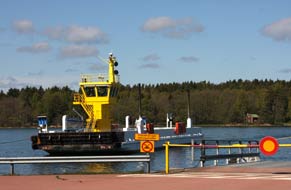 Driving
back down to Vårdö, we passed 3 other vehicles; this was the extent of the
island's afternoon 'rush hour'! Driving
back down to Vårdö, we passed 3 other vehicles; this was the extent of the
island's afternoon 'rush hour'!
There was still time this afternoon to explore
the outlying lanes and corners of Vårdö Island. Along at Vårdö By, we paused
to photograph the sturdy stone church engraved with its date of 1786 (Photo
18 - Vårdö Church), and drove down to the ferry dock at Hummelvik at the
island's SE corner where vehicles queued for the Northern Archipelago ferry line
boats crossing to Kumlinge and
Brandö, the easternmost group of the Åland Islands, and on to the Finnish mainland. Back across Vårdö, we found the island's
one shop, a small K-Market at Vargatu; here we bought a few items of provisions,
our small contribution to the island's economy, before returning to camp at Sandösund.
Today's nature walk had given us a good sampling of Vårdö's wild flora and we
were grateful for the loan of Olof's map, and to those islanders who had
way-marked this magnificently varied route. Tomorrow we should explore islands
of Sund and Saltvik.
 A hospitable welcome at Prästö Camping: after a chill and heavily overcast night, we woke to a still and sunny morning.
We packed and called in at the café to check the forecast on the campsite's
wi-fi, bidding farewell to Marina. As always, the sign of a good campsite is that
you are sorry to be leaving. Back over Vårdö Island, we crossed to Prästö on the
chain-ferry (see above right). We
had spent an enjoyable few days at the straightforward and hospitable Prästö
Camping
in 2012, but on telephoning we were disappointed to learn that it was not open
this year. Recalling our last visit however, the lady-owner insisted we could
camp there anyway. When we returned later to Prästö Camping, the lady-owner,
true to her word, had prepared a space for us on slightly raised ground given
forecast overnight rain, run out a long cable for our hook-up, and cleaned the
facilities ready for us. Given that the campsite was not officially open, her
hospitality was exemplary, and Prästö Camping made a memorable base for our
remaining 4 days on Åland
(see left) (Photo
19 - Prästö Camping). A hospitable welcome at Prästö Camping: after a chill and heavily overcast night, we woke to a still and sunny morning.
We packed and called in at the café to check the forecast on the campsite's
wi-fi, bidding farewell to Marina. As always, the sign of a good campsite is that
you are sorry to be leaving. Back over Vårdö Island, we crossed to Prästö on the
chain-ferry (see above right). We
had spent an enjoyable few days at the straightforward and hospitable Prästö
Camping
in 2012, but on telephoning we were disappointed to learn that it was not open
this year. Recalling our last visit however, the lady-owner insisted we could
camp there anyway. When we returned later to Prästö Camping, the lady-owner,
true to her word, had prepared a space for us on slightly raised ground given
forecast overnight rain, run out a long cable for our hook-up, and cleaned the
facilities ready for us. Given that the campsite was not officially open, her
hospitality was exemplary, and Prästö Camping made a memorable base for our
remaining 4 days on Åland
(see left) (Photo
19 - Prästö Camping).
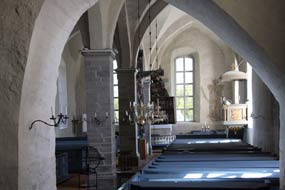 Sund Church: we drove on across the Bomarsund bridge, taking
a back lane to Sund Church. Set on a grassy hillside overlooking Kirksundet, a
long inlet from the sea, the Church of St John the Baptist (Johannes Döparens
Kyrka) is the largest of Åland's stone churches built around 1400. The nave is
dominated by a central line of sturdy Romanesque block-pillars so huge that they hide
the view of the altar from the church's west end (see right). Such bulky rustic building
style contrasted starkly with the delicately slender supporting columns of the
almost contemporary perpendicular Gothic architectural sophistication which was
evolving elsewhere in Europe (see left). A rough stone cross in the chancel bore the
inscription 'Wenni E', thought to be in memory of Bishop Wenni of Hamburg who
died converting the Ålanders to Christianity around 1250. But the church's real
treasure was the huge and ornately carved triptych altarpiece dating from the
13th century, with Mary Queen of Heaven holding the infant Christ in the centre
surrounded by rows of apostles (Photo
20 - Sund Church altar triptych). Sund Church: we drove on across the Bomarsund bridge, taking
a back lane to Sund Church. Set on a grassy hillside overlooking Kirksundet, a
long inlet from the sea, the Church of St John the Baptist (Johannes Döparens
Kyrka) is the largest of Åland's stone churches built around 1400. The nave is
dominated by a central line of sturdy Romanesque block-pillars so huge that they hide
the view of the altar from the church's west end (see right). Such bulky rustic building
style contrasted starkly with the delicately slender supporting columns of the
almost contemporary perpendicular Gothic architectural sophistication which was
evolving elsewhere in Europe (see left). A rough stone cross in the chancel bore the
inscription 'Wenni E', thought to be in memory of Bishop Wenni of Hamburg who
died converting the Ålanders to Christianity around 1250. But the church's real
treasure was the huge and ornately carved triptych altarpiece dating from the
13th century, with Mary Queen of Heaven holding the infant Christ in the centre
surrounded by rows of apostles (Photo
20 - Sund Church altar triptych).
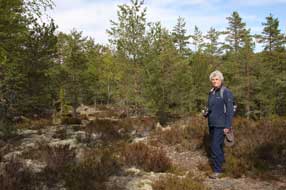 Lånbergen
hills in North Saltvik: our plan for the afternoon was to follow
another of the Mariehamn TIC's Hiking in Åland walks in the hills of Lånbergen
in North Saltvik from the signposted dirt road leading to a parking area up in
the pine and birch woods. From here an indistinct path led down the slope over
outcrops of granite slabs into the thinly forested valley. Palaeolithic seal
hunters are thought to have established a settlement (boplats) here in
what now is a valley bottom separating the Lånbergen hills but 5,000 years ago
higher sea levels then formed 2 islands with a flooded valley between them.
Today the bare granite sloping down into the valley was dotted with
pines, the forest floor covered with Ling and freshly green Bilberry laden with
its tiny pink flowers (Photo
21 - Bilberry flowers). Reaching the valley floor, we crossed the stream on a
plank-bridge and followed the path along the far side of the valley through the
pine and birch woods. We spent much time down among the ground cover
photographing the Bilberry flowers, aware however of the potential for adders
which are common in the Åland sandy heath-lands. Local enthusiasts have
reconstructed a Stone Age settlement by the lakes at the far end of the valley
and as we approached, a black grass snake slithered into one of the reed huts. Across the stream, a gravel track led up into
the Lånbergen hills lined with a variety of wild flora: flowering Bilberry and
Wild Strawberries, Lingonberry in tight bud, Violets and Coltsfoot. We stopped
frequently to photograph the wild flora, with the cuckoo sounding loudly across
the fell-side. The fell-side's bare granite outcrops, with trees and vegetation
surviving on the thin covering of remaining top-soil, were so typical of Åland's
glacier-scoured natural topography (see above left). Lånbergen
hills in North Saltvik: our plan for the afternoon was to follow
another of the Mariehamn TIC's Hiking in Åland walks in the hills of Lånbergen
in North Saltvik from the signposted dirt road leading to a parking area up in
the pine and birch woods. From here an indistinct path led down the slope over
outcrops of granite slabs into the thinly forested valley. Palaeolithic seal
hunters are thought to have established a settlement (boplats) here in
what now is a valley bottom separating the Lånbergen hills but 5,000 years ago
higher sea levels then formed 2 islands with a flooded valley between them.
Today the bare granite sloping down into the valley was dotted with
pines, the forest floor covered with Ling and freshly green Bilberry laden with
its tiny pink flowers (Photo
21 - Bilberry flowers). Reaching the valley floor, we crossed the stream on a
plank-bridge and followed the path along the far side of the valley through the
pine and birch woods. We spent much time down among the ground cover
photographing the Bilberry flowers, aware however of the potential for adders
which are common in the Åland sandy heath-lands. Local enthusiasts have
reconstructed a Stone Age settlement by the lakes at the far end of the valley
and as we approached, a black grass snake slithered into one of the reed huts. Across the stream, a gravel track led up into
the Lånbergen hills lined with a variety of wild flora: flowering Bilberry and
Wild Strawberries, Lingonberry in tight bud, Violets and Coltsfoot. We stopped
frequently to photograph the wild flora, with the cuckoo sounding loudly across
the fell-side. The fell-side's bare granite outcrops, with trees and vegetation
surviving on the thin covering of remaining top-soil, were so typical of Åland's
glacier-scoured natural topography (see above left).
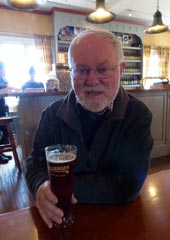 Stallhagen pub-microbrewery:
returning along the lanes, passing farms with lush pastures and freshly harrowed
fields of Åland fine, sandy soil, we reached Kvambo and turned south through
Haraldby to Godby the main village of Finström to shop for provisions at the
ever-reliable Mattsons supermarket. Our other reason for a return to Godby was
to re-visit the Stallhagen pub-microbrewery. Since its foundation in 2004,
Stallhagen has continued to increase its range and output of beers, produced by
their connoisseur Brew-master Matte Ekholm, while still retaining the 'Hand-made
Slow Beer' philosophy under the overall
directorship of the brewer's founder Christian Ekström whom we had met on our
first visit in 2012. Visit
Stallhagen Micro-brewery website
The micro-brewery's pub interior was just as we remembered it, and one of the
cheery bar-staff took us through the menu of today's beers; Sheila had a glass
of their Dark Honey Beer and Paul the Russian Pale, both full-bodied, tasty
beers and of course excellent
(Photo
22 - Stallhagen Pub-microbrewery) (see right). Stallhagen pub-microbrewery:
returning along the lanes, passing farms with lush pastures and freshly harrowed
fields of Åland fine, sandy soil, we reached Kvambo and turned south through
Haraldby to Godby the main village of Finström to shop for provisions at the
ever-reliable Mattsons supermarket. Our other reason for a return to Godby was
to re-visit the Stallhagen pub-microbrewery. Since its foundation in 2004,
Stallhagen has continued to increase its range and output of beers, produced by
their connoisseur Brew-master Matte Ekholm, while still retaining the 'Hand-made
Slow Beer' philosophy under the overall
directorship of the brewer's founder Christian Ekström whom we had met on our
first visit in 2012. Visit
Stallhagen Micro-brewery website
The micro-brewery's pub interior was just as we remembered it, and one of the
cheery bar-staff took us through the menu of today's beers; Sheila had a glass
of their Dark Honey Beer and Paul the Russian Pale, both full-bodied, tasty
beers and of course excellent
(Photo
22 - Stallhagen Pub-microbrewery) (see right).
Christian arrived back and greeted us like old
friends recalling our 2012 visit. We talked at length about the brewery's
continued development, the parallel growth of the gastro-pub business, and the
issue of balancing increased production with maintaining quality standards. An
inevitable topic of conversation was the result of the recent Finnish general
election in the context of the country's economic climate, and the impact of all
this on Åland. Stallhagen may not have many English beer-lover visitors, but
Christian certainly gave us a VIP welcome, presenting us with leaving gifts of
bottles of his hand-crafted Shipwreck beer,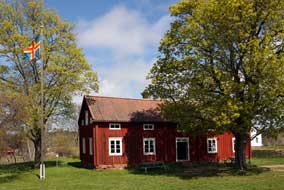 modelled on an early 19th
century bottled beer recovered from a wrecked schooner from the sea-bed off
Åland by Christian and his diving associates. modelled on an early 19th
century bottled beer recovered from a wrecked schooner from the sea-bed off
Åland by Christian and his diving associates.
The Jan Karlsgården Åland Skansen: it rained all night but the
following morning the sky had cleared and sun shining for our day around the
medieval churches of Saltvik, Geta and Finström. First stop however was the Jan
Karlsgården Åland Skansen which brings together in a beautiful rural setting
preserved historical farm buildings and windmills from around the islands; and
amazingly entry is free of charge. In bright sunshine, we ambled around the
farmstead buildings, with the distinctive Ålands flag steadfastly refusing to do
anything but hang limply in today's absence of any wind (see left). A group of visiting
school children played happily down by the decorated Midsummer Pole under the
birches with their fresh-green springtime leaf, and the post-windmill on the
hillside above the sound with its foreground of traditional Nordic fencing made
the perfect picture
(Photo
23 - Åland post-windmill).
The medieval churches of Saltvik, Geta and Finström: we drove on to
the Saltvik village of Kvambo to visit the Church of St Mary. One of the oldest
stone churches in Åland, the earliest parts date from the 13th century soon after
the islands' conversion to Christianity, but the church has been extended and
modified in the centuries since
(Photo
24 - Kvambo Church). The church's artwork included a 17th century
Baroque triptych altarpiece painted in naive rustic style with the Last Supper
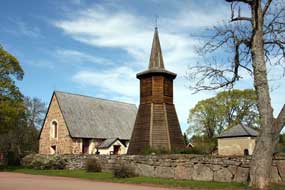 and Resurrection. Rather badly worn, painted wooden panels hung in the base of
the tower showing St George rescuing a distressed damsel from a particularly
inflammatory dragon (Photo
25 - Interior of Kvambo Church ). The carefully tended lawned area outside the graveyard had
from the earliest times been the meeting place for Åland's parliamentary
assembly, the Landsting, and a modern stele recorded this. and Resurrection. Rather badly worn, painted wooden panels hung in the base of
the tower showing St George rescuing a distressed damsel from a particularly
inflammatory dragon (Photo
25 - Interior of Kvambo Church ). The carefully tended lawned area outside the graveyard had
from the earliest times been the meeting place for Åland's parliamentary
assembly, the Landsting, and a modern stele recorded this.
We drove northward through Nääs, turning onto
Route 4 through fertile-looking farmlands and apple orchards to the village of
Geta and Sankt Gorans Kyrka (Church of St George). Built in the mid-15th
century, the church was simple in design with barrel-vaulted nave and small
separate wooden bell-tower (see right). Returning south to Pålsböle, we turned off to
Finström's Sankt Mikael Kyrka (Photo
26 - Finström Church). This more elaborate stone church was set in a
large and beautifully tended graveyard; we had been able in 2012 to see the
artwork of medieval frescoes and sculptures but today the church was locked.
Just by the porch, a WW2 memorial recorded the names of local men killed
throughout Europe and even in Japan.
A walk around the Bomarsund Russian Fortress: a
stay at Prästö Camping was an opportunity for another of Mariehamn TIC's Hiking in Åland walks,
the 4km circuit of Bomarsund Vandringsleden (Walking Path) around the fortress,
defensive towers and enceinte
 walls of Bomarsund, the monumental fortress built
by Imperial Russia during their 19th century occupation of the Åland Islands.
Following the Treaty of Hamina which concluded the 1808~09 war with Sweden, Tsarist
Russia gained possession not only of the whole of Finland but also the
strategically positioned Åland
Islands, and immediately began to fortify and garrison them as a furthest westward
defensive outpost of the Russian Empire. Work began on construction of the
massive fortress at Bomarsund as defence against Swedish retaliation. This epic walls of Bomarsund, the monumental fortress built
by Imperial Russia during their 19th century occupation of the Åland Islands.
Following the Treaty of Hamina which concluded the 1808~09 war with Sweden, Tsarist
Russia gained possession not only of the whole of Finland but also the
strategically positioned Åland
Islands, and immediately began to fortify and garrison them as a furthest westward
defensive outpost of the Russian Empire. Work began on construction of the
massive fortress at Bomarsund as defence against Swedish retaliation. This epic project to create a fortress to accommodate a garrison of up to 2,500 troops
would take decades, and brought to Åland 1000s of soldiers, penal gangs of
construction labourers, craftsmen, quarrymen and masons; such garrisons were the
most ethnically and religiously diverse communities reflecting the breadth of
the Russian Empire. Civilians with their families, along with civil servants,
and merchants, were stationed here in the township of Skarpans which grew up
around the fortress of Bomarsund. The massive walls of Bomarsund fortress, which
covered a large area by the channel between Sund and Prästö, were faced with
precisely cut granite blocks quarried locally in an attempt to make the fortress
cannon-proof. But when an attack from the west
came, it was not from Sweden. In 1854, the Western Allies sided with Ottoman
Turkey against Tsarist Russia in the Crimean War, and a combined British~French
naval squadron attacked Bomarsund. The enormous and seemingly impregnable
fortress had been under construction for 40 years and, despite its planned
scale, was in fact only 25% completed. Despite its formidable defences,
Bomarsund was no match against the Royal Navy's more modern weapons and tactics,
and fell within a matter of days. The Russians surrendered the fortress, the
incomplete construction work of 4 decades was destroyed by explosives, and under
the terms of surrender the Åland Islands became a demilitarised zone which it
remains today. The fortress was never rebuilt (see above left).
project to create a fortress to accommodate a garrison of up to 2,500 troops
would take decades, and brought to Åland 1000s of soldiers, penal gangs of
construction labourers, craftsmen, quarrymen and masons; such garrisons were the
most ethnically and religiously diverse communities reflecting the breadth of
the Russian Empire. Civilians with their families, along with civil servants,
and merchants, were stationed here in the township of Skarpans which grew up
around the fortress of Bomarsund. The massive walls of Bomarsund fortress, which
covered a large area by the channel between Sund and Prästö, were faced with
precisely cut granite blocks quarried locally in an attempt to make the fortress
cannon-proof. But when an attack from the west
came, it was not from Sweden. In 1854, the Western Allies sided with Ottoman
Turkey against Tsarist Russia in the Crimean War, and a combined British~French
naval squadron attacked Bomarsund. The enormous and seemingly impregnable
fortress had been under construction for 40 years and, despite its planned
scale, was in fact only 25% completed. Despite its formidable defences,
Bomarsund was no match against the Royal Navy's more modern weapons and tactics,
and fell within a matter of days. The Russians surrendered the fortress, the
incomplete construction work of 4 decades was destroyed by explosives, and under
the terms of surrender the Åland Islands became a demilitarised zone which it
remains today. The fortress was never rebuilt (see above left).
 Today's circular walk would give us chance to
see some of the surviving sections of Bomarsund's defences and to understand the
outmoded military thinking underlying the whole concept of what was a monumental
folly. Before setting out on the path however, we walked down to the rocky spit
of land projecting into Bomarsund Sound by the modern bridge to photograph the
surviving sections of main fortress walls
(see right) (Photo
27 - Bomarsund Bridge). Unwittingly we disturbed a
tern nesting on the flat rocks by the water's edge; its mate swooped over making
aggressive clicking sounds to drive us away from the nest. Crossing to the main
fortress' scant remains, closer examination showed just how sturdy the walls had
been, faced with artillery-proof octagonal granite
blocks (Photo
28 - Bomarsund Fortress walls). A way-marked path followed a gravelled road (of Russian origin) up to
the brick remains of Notviks Tower (see below left). Similar in design to the twinned tower on
the opposite side of Bomarsund Channel on Prästö Island, this defensive tower was
intended to guard the northern sea approaches to Bomarsund. The Russians assumed
that the deep water channel on the island's northern side was the only navigable
approach to the fortress, and built their principle defensive structure on what
was believed to be the side vulnerable Today's circular walk would give us chance to
see some of the surviving sections of Bomarsund's defences and to understand the
outmoded military thinking underlying the whole concept of what was a monumental
folly. Before setting out on the path however, we walked down to the rocky spit
of land projecting into Bomarsund Sound by the modern bridge to photograph the
surviving sections of main fortress walls
(see right) (Photo
27 - Bomarsund Bridge). Unwittingly we disturbed a
tern nesting on the flat rocks by the water's edge; its mate swooped over making
aggressive clicking sounds to drive us away from the nest. Crossing to the main
fortress' scant remains, closer examination showed just how sturdy the walls had
been, faced with artillery-proof octagonal granite
blocks (Photo
28 - Bomarsund Fortress walls). A way-marked path followed a gravelled road (of Russian origin) up to
the brick remains of Notviks Tower (see below left). Similar in design to the twinned tower on
the opposite side of Bomarsund Channel on Prästö Island, this defensive tower was
intended to guard the northern sea approaches to Bomarsund. The Russians assumed
that the deep water channel on the island's northern side was the only navigable
approach to the fortress, and built their principle defensive structure on what
was believed to be the side vulnerable
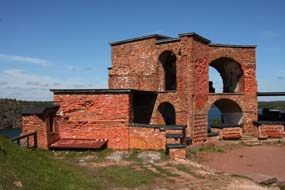 to naval attack. But almost as symbolic
of the outmoded and antiquated military strategic thinking underlying the whole
fortress concept, involving decades of expensive construction, so too was the
false assumption about vulnerability to direction of attack which failed to take
account of advances in military technology. By 1854, modern naval vessels, some
even steam-powered, could now navigate the narrow, shallow channels to the
south, well out of range of Notviks Tower's guns. And that was the direction
from which the Anglo-French fleet made its attack. Notviks Tower, and its twin
across the channel on Prästö, had each taken 5 years to construct and
was armed with 20 huge cannons, but all out-dated muzzle-loaders, slow to
re-load and prime once fired. In contrast the attacking British force, highly
manoeuvrable and mobile and armed with modern rapid-fire, breach-loading field
guns, took just 10 hours to capture the apparently impregnable defence-tower.
The entire static fortress concept of Bomarsund was for the Russians in 1854 as
antiquated in strategic thinking, military technology and construction time and
cost, as the Maginot Line was for the French in 1940. And in both cases, the
disastrous result was the same. And the story goes that, once Notviks Tower had
surrendered, the Russian commander invited the British in for a cup of tea! to naval attack. But almost as symbolic
of the outmoded and antiquated military strategic thinking underlying the whole
fortress concept, involving decades of expensive construction, so too was the
false assumption about vulnerability to direction of attack which failed to take
account of advances in military technology. By 1854, modern naval vessels, some
even steam-powered, could now navigate the narrow, shallow channels to the
south, well out of range of Notviks Tower's guns. And that was the direction
from which the Anglo-French fleet made its attack. Notviks Tower, and its twin
across the channel on Prästö, had each taken 5 years to construct and
was armed with 20 huge cannons, but all out-dated muzzle-loaders, slow to
re-load and prime once fired. In contrast the attacking British force, highly
manoeuvrable and mobile and armed with modern rapid-fire, breach-loading field
guns, took just 10 hours to capture the apparently impregnable defence-tower.
The entire static fortress concept of Bomarsund was for the Russians in 1854 as
antiquated in strategic thinking, military technology and construction time and
cost, as the Maginot Line was for the French in 1940. And in both cases, the
disastrous result was the same. And the story goes that, once Notviks Tower had
surrendered, the Russian commander invited the British in for a cup of tea!
Notviks Defensive Tower's red-brick structure
partially survives giving a clear impression of its shape and scale. No
wonder it took 5 years to build. 5 of the huge muzzle-loading cannons were still
in situ in the embrasures around the extant tower's walls (Photo
29 - Notviks Defensive Tower); another 9 cannon
barrels were lined up in a row along the approach road, each bearing the Romanov
double-eagle imperial crest (see right)
(Photo
30 - Notviks Tower cannons). We sat sheltering from the brisk Åland wind in the
lee of the remaining tower structure to eat our lunch sandwiches.
The next section of the walking route crossed
rougher terrain over pine-dotted bare granite outcrops, heading across this
typical Åland fell-side down into the valley at the head of Notviks narrow
inlet; the Russians had planned to build their deep-water harbour here at Bomarsund naval base for their Baltic fleet. Marker-posts indicated the ongoing
route's start point down across the granite slabs, with way-marks painted on
pine trees giving reassuring direction across the featureless fell-side. In fact
once out onto the granite-slabbed slope, it was magnificent terrain,
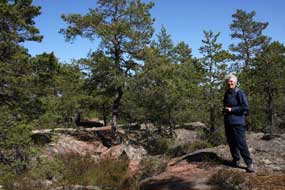 the path
clearly marked through the pines and the rough granite offering sure footing (Photo
31 - Bomarsund fell-side) (see left).
The path descended steeply into the narrow valley bottom which ran southward
from the head of Notviks inlet towards the main fortress, hemmed in on both
sides by pine-covered granite slopes the easterly of which we had just crossed.
During the period of Russian occupation, this area had been ear-marked as the
site of elaborate stone-built barrack blocks for the garrison, to replace the
wooden shacks that had originally housed the gangs of construction workers.
Although architects' drawings still exist, inevitably construction had not even
started when the fortress was destroyed in 1854. the path
clearly marked through the pines and the rough granite offering sure footing (Photo
31 - Bomarsund fell-side) (see left).
The path descended steeply into the narrow valley bottom which ran southward
from the head of Notviks inlet towards the main fortress, hemmed in on both
sides by pine-covered granite slopes the easterly of which we had just crossed.
During the period of Russian occupation, this area had been ear-marked as the
site of elaborate stone-built barrack blocks for the garrison, to replace the
wooden shacks that had originally housed the gangs of construction workers.
Although architects' drawings still exist, inevitably construction had not even
started when the fortress was destroyed in 1854.
The ongoing path rose steeply up the enclosing
western hillside among dense woodland, with 35m of wooden steps to negotiate the
sheer rocky escarpment. This brought us out onto more open granite fell-side
with clear views across the inlet to the now distant Notviks Tower on the far
headland and along the length of the wooded valley leading to the main fortress.
Continuing across the granite-slabbed hillside through pines, we reached a
gravel road up to the summit of Djävals Berget (Devil's Hill); the Russians had
planned another defensive tower here at what is Bomarsund's highest point , but
had got no further than levelling the 62m rocky high-point. From this vantage
point, we had a clear view over the wooded landscape showing just how much
ground the entire fortress would have covered had it ever been completed.
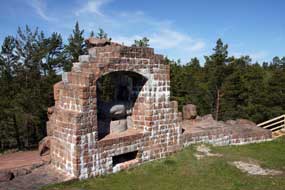 We continued around the final stretch of
pine-dotted fell-side to reach the remains of Brännklints Tower (see right), the only part
of the landward-facing defences to have been completed. In the 1854 attack,
French troops assaulted the tower with artillery but were held off by the 140
Russians occupying the defensive position inflicting heavy casualties. The
Russian defenders finally took the decision to abandon the tower, but while demolition
charges were being laid, the French managed to enter the tower and capture the
remaining occupants. The Russians now began to bombard the captured tower from
the main fortress, causing a fire which exploded the powder magazine. The French
then moved on for the final assault on the main fortress. The tower's surviving
façade showed evident impact marks of both small arms fire and explosive
shells from the French 1854 assault. A gravel track We continued around the final stretch of
pine-dotted fell-side to reach the remains of Brännklints Tower (see right), the only part
of the landward-facing defences to have been completed. In the 1854 attack,
French troops assaulted the tower with artillery but were held off by the 140
Russians occupying the defensive position inflicting heavy casualties. The
Russian defenders finally took the decision to abandon the tower, but while demolition
charges were being laid, the French managed to enter the tower and capture the
remaining occupants. The Russians now began to bombard the captured tower from
the main fortress, causing a fire which exploded the powder magazine. The French
then moved on for the final assault on the main fortress. The tower's surviving
façade showed evident impact marks of both small arms fire and explosive
shells from the French 1854 assault. A gravel track
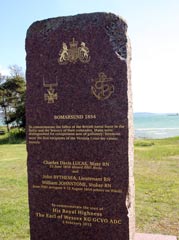 led downhill from here, and
just before the main road a diversion led to the foundation remains of the
fortress commander's headquarters; not merely a functional building, this was
designed as a grandiose Neo-Classical Empire-style mansion. led downhill from here, and
just before the main road a diversion led to the foundation remains of the
fortress commander's headquarters; not merely a functional building, this was
designed as a grandiose Neo-Classical Empire-style mansion.
Across the main road, another track-way
branched off past the remains of the military hospital and provisions stores;
both structures had doubled as part of the fortress' perimeter defences. Nearby
were the foundation remains of a further defensive tower, construction of which
had not even begun. The track-way passed the foundation remains of the civilian
township of Nya Skarpans which had grown up in the shadow of the fortress, and
down at the shore-side those sections of fortress walls which survived the
post-capture destruction. Out on the headland, a memorial had been set up to
commemorate the visit by the Earl of Wessex in February 2015. The stele recorded
the names of the first recipients of the newly instigated Victoria Cross for
acts of conspicuous bravery in the 1854 Bomarsund campaign (see left).
This had been another fulfilling day around
Bomarsund: the path had been well-marked and showed much of the fortress remains
not usual visible to the average tourists. We had leaned much about Russian
imperial arrogance and military ignorance that had cost so many lives. The
entire fortress had been one monumental folly, totally ineffectual and based on
outmoded strategic thinking and antiquated military hardware technology, and in
the event easily succumbed to attacked by the Royal Navy.
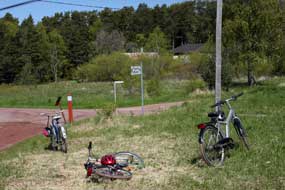 A walk around Prästö Island with its Russian
graveyards:
our final day on Åland would be spent walking the circuit of Prästö Island,
another of the Hiking in Åland way-marked walks. From the campsite, we
walked along the lane where the road-side embankment was a real garden of
attractive wild flora: Wood Anemones, Wood Sorrel, Water Avens, Cowslips and
most special of all, beautiful blue-mauve Hepatica. At the corner we reached the
former telegraph building built in 1910 as a radio link with St Petersburg when
the Russians re-garrisoned Åland in violation of the 1854 demilitarisation
treaty. 3 cycles with cycle helmets were left unsecured on the road-side verge by local children catching
their school bus (see right), yet another symbol of Åland's civilised lifestyle. The
way-marked path led on from here through tall pines where we spotted a Black
Woodpecker, the largest of the European woodpeckers with its characteristic head-back stance and noisy drumming. As we photographed a clump of Bilberry
flowers, a lady at one of the wooden cottages greeted us, again surprised to
hear we were from England. She said our path would lead past her potato patch,
fenced to protect it from the island's muntjac deer; as we stood watching the
woodpecker, a small muntjac scampered across the scrub in front of us, perhaps
one of the potato foragers! The path led across to a jetty by the Prästö channel
where we sat for our lunch sandwiches watching the ferry chugging back and forth
with the woodpecker's laughing call and drumming echoing around the woods.
Through the dark pinewoods where lovely Wood Sorrel and Hepatica (Photo
32 - Hepatica - Hepatica nobilis) grew in the moist
shade, the path emerged into bright sunshine at the road where the continuing
track-way led to the enclosures of Russian graves. During the 19th century
Russian occupation of Bomarsund, Prästö Island became a large burial ground with
many of the garrison and A walk around Prästö Island with its Russian
graveyards:
our final day on Åland would be spent walking the circuit of Prästö Island,
another of the Hiking in Åland way-marked walks. From the campsite, we
walked along the lane where the road-side embankment was a real garden of
attractive wild flora: Wood Anemones, Wood Sorrel, Water Avens, Cowslips and
most special of all, beautiful blue-mauve Hepatica. At the corner we reached the
former telegraph building built in 1910 as a radio link with St Petersburg when
the Russians re-garrisoned Åland in violation of the 1854 demilitarisation
treaty. 3 cycles with cycle helmets were left unsecured on the road-side verge by local children catching
their school bus (see right), yet another symbol of Åland's civilised lifestyle. The
way-marked path led on from here through tall pines where we spotted a Black
Woodpecker, the largest of the European woodpeckers with its characteristic head-back stance and noisy drumming. As we photographed a clump of Bilberry
flowers, a lady at one of the wooden cottages greeted us, again surprised to
hear we were from England. She said our path would lead past her potato patch,
fenced to protect it from the island's muntjac deer; as we stood watching the
woodpecker, a small muntjac scampered across the scrub in front of us, perhaps
one of the potato foragers! The path led across to a jetty by the Prästö channel
where we sat for our lunch sandwiches watching the ferry chugging back and forth
with the woodpecker's laughing call and drumming echoing around the woods.
Through the dark pinewoods where lovely Wood Sorrel and Hepatica (Photo
32 - Hepatica - Hepatica nobilis) grew in the moist
shade, the path emerged into bright sunshine at the road where the continuing
track-way led to the enclosures of Russian graves. During the 19th century
Russian occupation of Bomarsund, Prästö Island became a large burial ground with
many of the garrison and
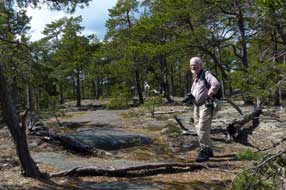 civilian population dying from epidemics. Surrounded by
sturdy walls of granite blocks, the 6 graveyards were divided into sections reflecting the religious origins of the many nationalities from around the
Tsarist Empire: soldiers and POW construction workers drafted to this western
outpost of empire, together with merchants and civilians attracted to the
settlement which developed around the fortress. Most of the grave-markers would
have been wooden and have long since rotted away, but a few engraved stone
monuments remain. civilian population dying from epidemics. Surrounded by
sturdy walls of granite blocks, the 6 graveyards were divided into sections reflecting the religious origins of the many nationalities from around the
Tsarist Empire: soldiers and POW construction workers drafted to this western
outpost of empire, together with merchants and civilians attracted to the
settlement which developed around the fortress. Most of the grave-markers would
have been wooden and have long since rotted away, but a few engraved stone
monuments remain.
The first graveyard was the New Russian
Orthodox burial ground begun in 1842 with 5 stone monuments to a Russian
merchant and his family and a military engineer and his son. Nearby was a small
area for Catholic burials; these would have been Poles drafted here as POWs from
the crushed Polish national rebellion against Russian rule in 1830~31. Only 2 of
the gravestones survive. The next graveyard was for those of Lutheran faith,
mainly Finnish and other non-Russian soldiers and their families. The Lutheran
burial ground was consecrated in 1846 and is still in use for local Lutheran
burials from Prästö. The way-marked pathway led across to the far side of the
Orthodox cemetery, shelving through dark pine woods along the lower part of an
escarpment, then climbing its way up through the rocks of a low cliff, finally
mounting the sheer upper section on a wooden stairway to emerge onto the bare
granite slabbed summit plateau of Ångsbergen. We followed the route across the
plateau, its exposed granite outcrops dotted with pines and covered with lichen.
In the afternoon sunshine, this was a truly exquisite setting and the highlight
of a day of highlights (Photo
33 - Ångsbergen summit plateau) (see above left). At the highest point, a wooden observation tower gave a
panorama across Prästö's multi-green forest-scape to the surrounding sea.
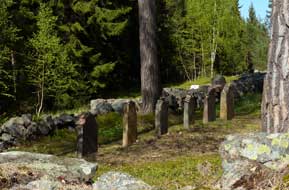 We descended from the plateau through the pines
and Bilberry to a forest track-way which branched off through dark, damp pine
woods where by the path a perfect patch of the blue-mauve Hepatica grew. The
path emerged at the western side of the island into area of the oldest Orthodox
cemetery used by the majority Russian Orthodox community at Bomarsund. It was
consecrated soon after the occupation of Åland in 1815 near to the military
hospital on Prästö. Most of the wooden Orthodox 3-barred crosses grave-markers
have long since disappeared, the only evidence now of burials being the
undulations of the ground, now grazed by sheep and lambs. By 1840 this burial
area had been filled leading to the creation of the New Orthodox Cemetery on the
island's eastern side which we had passed earlier. A little further beyond a
fringe of pines, sturdy granite-block walls enclosed cemeteries segregated for
Jewish and Muslim burials from Bomarsund. The first area contained 6 surviving
Jewish grave-stones engraved with Hebrew text on one side and Cyrillic on
the reverse (see right). It is not known whether other Jewish burials were made here, but in
1854 the Jewish community at Bomarsund numbered around 100. The far enclosure
was for Muslim burials; no grave-markers survive and it is not known how many
burial were made here although some mounds remain. Little is known of the Muslim
community at Bomarsund, but it is likely they were POW penal companies who worked
as labourers. The first half of the 19th century was for Russia a period of
conflict with Islamic nations, with repeated wars against the Ottoman Turks and
numerous rebellions in the newly occupied Caucasus provinces; it is most likely
therefore that Muslims at Bomarsund We descended from the plateau through the pines
and Bilberry to a forest track-way which branched off through dark, damp pine
woods where by the path a perfect patch of the blue-mauve Hepatica grew. The
path emerged at the western side of the island into area of the oldest Orthodox
cemetery used by the majority Russian Orthodox community at Bomarsund. It was
consecrated soon after the occupation of Åland in 1815 near to the military
hospital on Prästö. Most of the wooden Orthodox 3-barred crosses grave-markers
have long since disappeared, the only evidence now of burials being the
undulations of the ground, now grazed by sheep and lambs. By 1840 this burial
area had been filled leading to the creation of the New Orthodox Cemetery on the
island's eastern side which we had passed earlier. A little further beyond a
fringe of pines, sturdy granite-block walls enclosed cemeteries segregated for
Jewish and Muslim burials from Bomarsund. The first area contained 6 surviving
Jewish grave-stones engraved with Hebrew text on one side and Cyrillic on
the reverse (see right). It is not known whether other Jewish burials were made here, but in
1854 the Jewish community at Bomarsund numbered around 100. The far enclosure
was for Muslim burials; no grave-markers survive and it is not known how many
burial were made here although some mounds remain. Little is known of the Muslim
community at Bomarsund, but it is likely they were POW penal companies who worked
as labourers. The first half of the 19th century was for Russia a period of
conflict with Islamic nations, with repeated wars against the Ottoman Turks and
numerous rebellions in the newly occupied Caucasus provinces; it is most likely
therefore that Muslims at Bomarsund were POWs from these conflicts. were POWs from these conflicts.
From the far corner of the Orthodox cemetery,
the path climbed over a rocky outcrop at the head of a small inlet, dropping
down to pass one of the former stone quarries where masons had cut and shaped
the octagonal granite blocks for facing the fortress' walls. A side track
branched off along a peninsula leading to the outlying defensive tower at the
northern tip of Prästö just opposite the Notviks tower across the sound. Built
as much to impress as for defence, little now remained of the once sturdy
structure which over the years had been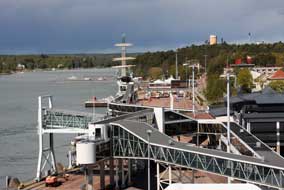 plundered for stone and brick building materials. Back along the lane to Prästö Camping for our final evening on Åland,
we were able to sit outside in the warm sunshine after a perfect day of weather,
walking, wild flora and historical interest. We settled up with the owners,
thanking them for their hospitality; it had indeed been another memorable stay
at this delightfully peaceful setting. Our 9 days on Åland had been both
fulfilling and relaxing; this was an enviably civilised society which emphasised
the extent to which the rest of Western Europe, and UK in particular,
had degenerated in terms of quality of life, good manners and civility. We shall
doubtless return. plundered for stone and brick building materials. Back along the lane to Prästö Camping for our final evening on Åland,
we were able to sit outside in the warm sunshine after a perfect day of weather,
walking, wild flora and historical interest. We settled up with the owners,
thanking them for their hospitality; it had indeed been another memorable stay
at this delightfully peaceful setting. Our 9 days on Åland had been both
fulfilling and relaxing; this was an enviably civilised society which emphasised
the extent to which the rest of Western Europe, and UK in particular,
had degenerated in terms of quality of life, good manners and civility. We shall
doubtless return.
Ferry to Turku on SW Finnish mainland:
back into Mariehamn, we stocked up with provisions and headed down to the docks
and the Viking Line ferry terminal, joining the short queue of vehicles for the
ferry to Turku on the Finnish SW mainland (see above left). Ferries queued to dock at Mariehamn
port, and
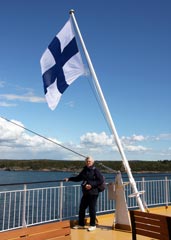 sooner than expected our ferry M/S Grace drew in. Having
reversed into the hold and parked among the lorries and buses, there was just
time to dash up to deck 12 to photograph our departure from Mariehamn docks
against the backdrop of the sailing ship
Pommern moored in the harbour (Photo
34 - Departing Mariehamn harbour) (see above right); from the ferry rail beside the
Finnish stern flag, we waved farewell to the Ålands for this year (see left) (Photo
35 - Farewell to the Ålands). The ferry was crowded with noisy Finns returning from
holiday in Sweden, but we found seats in the lounge as the ferry threaded its
tortuous route between all the wooded islets and skerries of the Turku
archipelago, seeming to skirt alarmingly close to the rocky outcrops. With
George being first in line to drive off the ferry, we went down early to the hold at
7-30pm; never before had we had access to the car deck before the ferry docked.
Daylight began to appear as the tail-door began to lower, and we drove ashore
amid the confusion of Turku dockland. Traffic fortunately was light on a
Saturday evening as we drove along Linnankatu towards the centre, soon
recognising our whereabouts. Across the river, we turned steeply uphill into
Route 110 out to Turku's southern outskirts and turned off towards Pargas. It
was 8-3pm as we approached Solliden Camping. sooner than expected our ferry M/S Grace drew in. Having
reversed into the hold and parked among the lorries and buses, there was just
time to dash up to deck 12 to photograph our departure from Mariehamn docks
against the backdrop of the sailing ship
Pommern moored in the harbour (Photo
34 - Departing Mariehamn harbour) (see above right); from the ferry rail beside the
Finnish stern flag, we waved farewell to the Ålands for this year (see left) (Photo
35 - Farewell to the Ålands). The ferry was crowded with noisy Finns returning from
holiday in Sweden, but we found seats in the lounge as the ferry threaded its
tortuous route between all the wooded islets and skerries of the Turku
archipelago, seeming to skirt alarmingly close to the rocky outcrops. With
George being first in line to drive off the ferry, we went down early to the hold at
7-30pm; never before had we had access to the car deck before the ferry docked.
Daylight began to appear as the tail-door began to lower, and we drove ashore
amid the confusion of Turku dockland. Traffic fortunately was light on a
Saturday evening as we drove along Linnankatu towards the centre, soon
recognising our whereabouts. Across the river, we turned steeply uphill into
Route 110 out to Turku's southern outskirts and turned off towards Pargas. It
was 8-3pm as we approached Solliden Camping.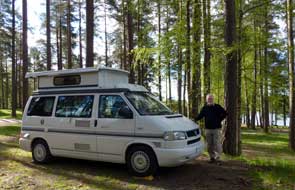
Solliden Camping near Pargas:
we had stayed at Solliden Camping 20 kms south of Turku in 2012 since it is the
only campsite open this early in the year; the then owners were effusively
welcoming and charged a modest amount including a Camping Card discount. There
were now new owners who had just completed a new facilities building and now
charged an unprecedented €30; we had no other choice for tonight, and settled
into the wooded hill-top camping area under the pines (see right). Tomorrow we should begin
our foray out along the Turku Archipelago trail (see
Turku
Archipelago Trail),
across the 4 main islands of Nagu-Nauvo, Korpo, Houtskär and Mossala, part of
the fragmented network of 25,000 islands, islets and skerries which dot the seas
westwards from the Finnish mainland at Turku stretching outwards towards the
Åland archipelago. The peacefulness of those lovely islands tonight seemed a
universe away; we were missing it already.
The following morning, with the sun shining
down through the pines, an inspection of the new Solliden facilities building
showed its ludicrous ill-design and ineffectually dysfunctional misuse of space:
the building was twice the size it need have been, since less than 50% of the
internal space was used purposefully. The showers had few pegs and no benches
for belongings and towel, and the ineffectual ventilation left the room
steam-laden and walls streaming with condensation. Whoever was responsible for
such an expensive but space-wasteful abortion should be struck off any approved
list of designers; and we were being charged an outrageous €30 to pay for it.
Naturally we shall NOT on our return to Turku stay at Solliden which may well be
the only Finnish campsite to merit a negative score in our Campsite Review.
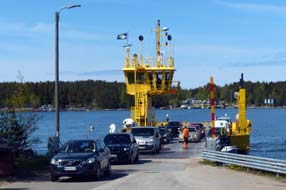 Ferries out across the Archipelago islands: on
a pleasantly sunny Whit Sunday morning, we drove past Pargas to reach the
ferry-port at Lillmälö for the 11-15am ferry. There were a total of 5 ferries
making up today's progression out across the archipelago of islands, mostly
short hops across intervening stretches of water between the islands, with one
longer 30 minute crossing to Houtskär. We were unsure at this stage if any or
all would entail payments. We did at least have a copy of the Finferries
timetables for all the ferries on our route. The first ferry-crossing from the
Pargas mainland over to Prostvik at the eastern end of the island of Nagu-Nauvo
took only 10 minutes. The chain-ferry chugged back across the narrows and George
drove aboard; no one came round for fares payment, so this one at least was free
of charge as part of the archipelago public road network. Across at Prostvik, we
drove ashore to continue forward across the much indented Nagu-Nauvo island,
whose landscape was largely pine and birch wooded interspersed with farm
pastureland. Across 2 bridged channels, we reached Nagu-Nauvo's main village of
Nagu where both shops were closed for the Whit Sunday holiday. But with no rush
for the subsequent ferries, we paused at the 14th century church which is said to house
Finland's oldest Bible (Photo
36 - Nagu Church). But since the local congregation was enjoying their
lengthy Lutheran Whitsuntide service, we were unable to see it, and instead
photographed the church's Ferries out across the Archipelago islands: on
a pleasantly sunny Whit Sunday morning, we drove past Pargas to reach the
ferry-port at Lillmälö for the 11-15am ferry. There were a total of 5 ferries
making up today's progression out across the archipelago of islands, mostly
short hops across intervening stretches of water between the islands, with one
longer 30 minute crossing to Houtskär. We were unsure at this stage if any or
all would entail payments. We did at least have a copy of the Finferries
timetables for all the ferries on our route. The first ferry-crossing from the
Pargas mainland over to Prostvik at the eastern end of the island of Nagu-Nauvo
took only 10 minutes. The chain-ferry chugged back across the narrows and George
drove aboard; no one came round for fares payment, so this one at least was free
of charge as part of the archipelago public road network. Across at Prostvik, we
drove ashore to continue forward across the much indented Nagu-Nauvo island,
whose landscape was largely pine and birch wooded interspersed with farm
pastureland. Across 2 bridged channels, we reached Nagu-Nauvo's main village of
Nagu where both shops were closed for the Whit Sunday holiday. But with no rush
for the subsequent ferries, we paused at the 14th century church which is said to house
Finland's oldest Bible (Photo
36 - Nagu Church). But since the local congregation was enjoying their
lengthy Lutheran Whitsuntide service, we were unable to see it, and instead
photographed the church's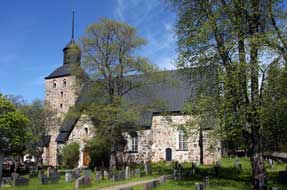 exterior and the 1918 Finnish Civil War memorial
listing only the White faction dead of Jäger battalions; with victors' arrogance
in what was a civil class struggle, the engraved heading recorded the Civil War
as 'Finland's freedom struggle'; doubtless the Reds faction would have seen it
otherwise. exterior and the 1918 Finnish Civil War memorial
listing only the White faction dead of Jäger battalions; with victors' arrogance
in what was a civil class struggle, the engraved heading recorded the Civil War
as 'Finland's freedom struggle'; doubtless the Reds faction would have seen it
otherwise.
We continued across the western half of
Nagu-Nauvo, reaching the ferry-dock of Pärnäs just in time for the 12-22 ferry
across the straits to Retais at the eastern end of Korpo, the next island in the
chain (Photo
37 - Nagu-Nauvo~Korpo chain-ferry) (see above left). Again there was no charge for
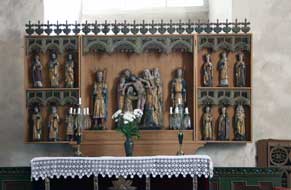 the 5 minute crossing,
and we drove ashore
onto Korpo. The next phase of our outward journey was the longer 30 minute ferry
crossing from Galtby on the north coast of Korpo over to the outermost of the
larger islands, Houtskär. Ferries were less frequent, but we had plenty of time
before the 13-55 ferry to divert into Korpo village to see the medieval church
(see right).
The church of St Mikael the Archangel was built in the 13th century, and still
has a number of medieval works of art including a wood carving of St George
skewering his dragon, a painting of St Catherine of Alexandria treading on the
Christian persecuting Roman Emperor Maximian, a altar triptych with preserved
15th century carved figures set in a 1950s frame (see left), and a unique choir gallery
spanning the entrance to the chancel . But the church's masterpiece were the
medieval rustic wall-paintings covering the Gothic vaulting (Photo
38 - Medieval artwork at Korpo Church). In a quiet corner
of the graveyard by the north porch, we found a 1939~44 Winter and Continuation
War cemetery with the names of 14 local dead recorded on the memorial and pine
wreath decorated with ribbons in Finland's blue and white national colours laid
at the foot of the monument. the 5 minute crossing,
and we drove ashore
onto Korpo. The next phase of our outward journey was the longer 30 minute ferry
crossing from Galtby on the north coast of Korpo over to the outermost of the
larger islands, Houtskär. Ferries were less frequent, but we had plenty of time
before the 13-55 ferry to divert into Korpo village to see the medieval church
(see right).
The church of St Mikael the Archangel was built in the 13th century, and still
has a number of medieval works of art including a wood carving of St George
skewering his dragon, a painting of St Catherine of Alexandria treading on the
Christian persecuting Roman Emperor Maximian, a altar triptych with preserved
15th century carved figures set in a 1950s frame (see left), and a unique choir gallery
spanning the entrance to the chancel . But the church's masterpiece were the
medieval rustic wall-paintings covering the Gothic vaulting (Photo
38 - Medieval artwork at Korpo Church). In a quiet corner
of the graveyard by the north porch, we found a 1939~44 Winter and Continuation
War cemetery with the names of 14 local dead recorded on the memorial and pine
wreath decorated with ribbons in Finland's blue and white national colours laid
at the foot of the monument.
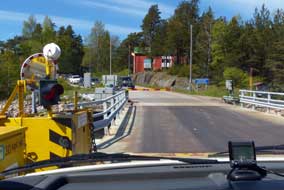 We returned along to Galtby ferry dock, a busy
little port from where 3 different routes depart. Our ferry drew in and we drove
aboard for the half hour crossing to Kittuis at the SE corner of Houtskär,
surprised that even this longer crossing was free-of-charge (Photo
39 - Galtby~Houtskär ferry). Ashore at Houtskär,
the lane across the island became single-track with passing places, but there
was little traffic. Just beyond Näsby, a chain-ferry took us across the narrows
to Kivimo, and around this curving island to Björkö, a final chain-ferry crossed
to the outermost island of Mossala, carrying George, a tractor and 2 little boys
on bikes (see right). Across to the northern coast of tiny Mossala just by the ferry-dock,
we reached tonight's campsite, Saariston Lomskeskus (Holiday Centre). Out of
season, the reception was unmanned but a telephone call to the owner brought a
welcoming response to settle in at the camping area and he would call round
later. The grounds were beautifully laid out looking out to the coast at the
north and surrounded by pine woods, with a gravelled camping area and small
facilities hut with WCs, showers, free sauna, wash-up, site-wide wi-fi internet
and We returned along to Galtby ferry dock, a busy
little port from where 3 different routes depart. Our ferry drew in and we drove
aboard for the half hour crossing to Kittuis at the SE corner of Houtskär,
surprised that even this longer crossing was free-of-charge (Photo
39 - Galtby~Houtskär ferry). Ashore at Houtskär,
the lane across the island became single-track with passing places, but there
was little traffic. Just beyond Näsby, a chain-ferry took us across the narrows
to Kivimo, and around this curving island to Björkö, a final chain-ferry crossed
to the outermost island of Mossala, carrying George, a tractor and 2 little boys
on bikes (see right). Across to the northern coast of tiny Mossala just by the ferry-dock,
we reached tonight's campsite, Saariston Lomskeskus (Holiday Centre). Out of
season, the reception was unmanned but a telephone call to the owner brought a
welcoming response to settle in at the camping area and he would call round
later. The grounds were beautifully laid out looking out to the coast at the
north and surrounded by pine woods, with a gravelled camping area and small
facilities hut with WCs, showers, free sauna, wash-up, site-wide wi-fi internet
and
 free washing/drying machines; with its delightfully peaceful setting, the
air filled with bird song, and at €22/night out of season and a range of free
facilities and helpful pwner, this was exceptionally good value campsite (Photo
40 - Saariston Lomskeskus) (see left). We happily settled in, put on a
load of washing and sat enjoying the glorious surroundings. The owner came round
later to welcome us, and apologised that the wi-fi was temporarily out of
action; he would get it fixed as soon as possible, he promised free washing/drying machines; with its delightfully peaceful setting, the
air filled with bird song, and at €22/night out of season and a range of free
facilities and helpful pwner, this was exceptionally good value campsite (Photo
40 - Saariston Lomskeskus) (see left). We happily settled in, put on a
load of washing and sat enjoying the glorious surroundings. The owner came round
later to welcome us, and apologised that the wi-fi was temporarily out of
action; he would get it fixed as soon as possible, he promised
A relaxing stay at Saariston Lomskeskus on Mossala Island:
our plan was for a relaxing couple of days enjoying the wonderful surroundings
and peaceful setting on the north coast of Mossala Island, and to begin our
writing up of our stay on the Ålands. The campsite's impeccable array of
spotlessly clean and modern facilities and magnificent setting would ensure a
comfortable stay. As the day progressed, the cloud began to break to give lovely
clear, warm sunshine. The owner came round late afternoon to say the wi-fi would
be working tomorrow, and in the meantime we could use the wi-fi down at the
small marina by the ferry dock. We asked about weather forecast for tomorrow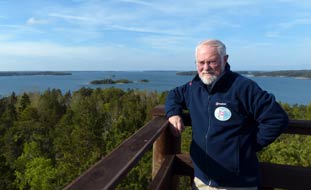 and
for Helsinki later in the week; he obligingly returned with prints for each, and
recommended we take advantage of the current sunny weather to walk up to the
lookout tower on the low hill just beyond the campsite overlooking the coast and
multitude of small islands. A delightful path led up the slope of the
pine-covered hillock to the wooden tower which looked out across the
archipelago's outer islands (see right). and
for Helsinki later in the week; he obligingly returned with prints for each, and
recommended we take advantage of the current sunny weather to walk up to the
lookout tower on the low hill just beyond the campsite overlooking the coast and
multitude of small islands. A delightful path led up the slope of the
pine-covered hillock to the wooden tower which looked out across the
archipelago's outer islands (see right).
The following morning, the sky was heavily
overcast with misty drizzle hovering around the coast. Before the threatening
rain started, we took laptop down to the marina and sat on the veranda of one of
the huts looking across to the ferry-dock, and connected to a strong wi-fi
signal. Technological miracles are never to be scorned or taken lightly: we sat
here on with rain pattering on the veranda roof on a chill, misty morning on the
northern coast of a tiny Bothnian Gulf Island, and enjoyed a round-the-world Skype
video call with our daughter in Adelaide South Australia. Returning to the
camping area, the wi-fi there was now working as the campsite owner had
promised, enabling us to settle in for a full day's work as the insistent rain
worsened.
 Our final morning at Saariston Lomskeskus, and the
sky had cleared overnight to give bright, warming sun; the weather was so
perfect this morning that we were able to sit out for breakfast, and both took
advantage of the campsites free saunas. We had indeed enjoyed 2 relaxing and
fulfilling days here at this remote but delightful campsite on the outermost
island of the Archipelago. The owner again came round for us to settle up our 3
days' rent, and we complemented him on the lovely campsite and thanked him for his
hospitality; he described the huge task of transforming the naturally undrained,
swampy forest land into the beautiful parkland of the campsite's present beautiful
environment; his hard work showed and he could feel rightly proud of what he had
achieved. Our final morning at Saariston Lomskeskus, and the
sky had cleared overnight to give bright, warming sun; the weather was so
perfect this morning that we were able to sit out for breakfast, and both took
advantage of the campsites free saunas. We had indeed enjoyed 2 relaxing and
fulfilling days here at this remote but delightful campsite on the outermost
island of the Archipelago. The owner again came round for us to settle up our 3
days' rent, and we complemented him on the lovely campsite and thanked him for his
hospitality; he described the huge task of transforming the naturally undrained,
swampy forest land into the beautiful parkland of the campsite's present beautiful
environment; his hard work showed and he could feel rightly proud of what he had
achieved.
From this northern tip of Mossala, the onward ferry
continues to the island of Iniö to complete the full circuit of the Archipelago
Trail (see left), eventually leading back to the mainland north of Turku. We unfortunately
were too early in the year to take that route, since the onward ferries do not
begin operating until June. We should have to return by our outward route along
the southern part of the archipelago, and leaving Saariston Lomskeskus, set off
back via the sequence of islands and ferries, to reach the mainland at Pargas.
Having re-stocked with provisions there, we set the satnav for Helsinki to begin
the next phase of our Finnish trip at the country's capital city. More of that
in our next edition.
Next edition
to be published quite soon
|
Sheila and Paul |
Published: 12 July 2015
at Savukoski |
|
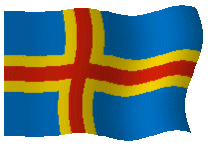
 CAMPING
IN FINLAND 2015 - Åland Islands and Turku Archipelago:
CAMPING
IN FINLAND 2015 - Åland Islands and Turku Archipelago: The crossing of the magnificent engineering
structure of the Öresund
Bridge (see left), though expensive at €47, never ceases to impress (
The crossing of the magnificent engineering
structure of the Öresund
Bridge (see left), though expensive at €47, never ceases to impress ( Ferry to the Åland
Islands: early the following
morning with a leaden sky, we joined the queue of vehicles down at the
dock for the 9-30 Viking Line ferry sailing for Mariehamn in the Åland Islands
midway across the Bothnian Gulf between Sweden and Finland (see left).
From M/S Rosella's aft deck, we took our departing photos as the ferry
pulled away from the Swedish mainland,
with the Åland flag gusting in the stiff breeze
(
Ferry to the Åland
Islands: early the following
morning with a leaden sky, we joined the queue of vehicles down at the
dock for the 9-30 Viking Line ferry sailing for Mariehamn in the Åland Islands
midway across the Bothnian Gulf between Sweden and Finland (see left).
From M/S Rosella's aft deck, we took our departing photos as the ferry
pulled away from the Swedish mainland,
with the Åland flag gusting in the stiff breeze
( Söderhagen Camping in Eckerö: in
the pouring rain, Åland's landscape looked dismally sodden as we drove westwards
across Hammarland island and crossed to Eckerö to turn off to the hamlet of
Torp. We had first stayed at Söderhagen Camping in 2012 and had kept in touch
with the owners Sven and Susanna Eklund since then; as we arrived at the
campsite, the familiar jovial figure of Sven drew up in
Söderhagen Camping in Eckerö: in
the pouring rain, Åland's landscape looked dismally sodden as we drove westwards
across Hammarland island and crossed to Eckerö to turn off to the hamlet of
Torp. We had first stayed at Söderhagen Camping in 2012 and had kept in touch
with the owners Sven and Susanna Eklund since then; as we arrived at the
campsite, the familiar jovial figure of Sven drew up in his pick-up and greeted
us like long-lost friends. We settled onto the formerly forested hillock
overlooking the Torpfjärden inlet of the sea where by sheer hard graft, Sven had
created the now cleared and levelled camping area (see left). How good it was to be back;
we could relax with a feeling that our outward journeying was now complete.
The rain had eased but it was still bleakly cold as Sven told us of his work of
the last 3 years in clearing further forest to enlarge the camping; thanks
to his efforts in draining the land, there was no trace of water-logging despite
12 hours of continuous rain.
his pick-up and greeted
us like long-lost friends. We settled onto the formerly forested hillock
overlooking the Torpfjärden inlet of the sea where by sheer hard graft, Sven had
created the now cleared and levelled camping area (see left). How good it was to be back;
we could relax with a feeling that our outward journeying was now complete.
The rain had eased but it was still bleakly cold as Sven told us of his work of
the last 3 years in clearing further forest to enlarge the camping; thanks
to his efforts in draining the land, there was no trace of water-logging despite
12 hours of continuous rain. in the
surrounding pine and birch woods, and a redstart perched on a nearby post. Today
we should enjoy a relaxing day around Eckerö. Along the gravel lane we parked
down at Degersand to walk through to the deserted wild beach which enclosed this
beautiful bay
(
in the
surrounding pine and birch woods, and a redstart perched on a nearby post. Today
we should enjoy a relaxing day around Eckerö. Along the gravel lane we parked
down at Degersand to walk through to the deserted wild beach which enclosed this
beautiful bay
( hamlet of Torp is
quintessentially Åland with its windmill
(
hamlet of Torp is
quintessentially Åland with its windmill
( and we were forced to
wear Arctic layers for warmth. The driving rain and miserably cold NW wind
continued unabated all day; this was supposed to be the mild south, and in
comparison our past experience made being north of the Arctic Circle seem
positively tropical!
and we were forced to
wear Arctic layers for warmth. The driving rain and miserably cold NW wind
continued unabated all day; this was supposed to be the mild south, and in
comparison our past experience made being north of the Arctic Circle seem
positively tropical! him farewell for perhaps another couple of years, and drove westwards back
towards the outskirts of Mariehamn, where we turned off for the Ramsholmen Nature
Walk, one of the excellent series of Åland walks published by the Mariehamn TIC.
The Ramsholmen peninsula is one of the few surviving areas of wooded meadows in Åland
from which the mown hay and pollarded foliage of ash trees was once used as
winter feed for cattle. The walk started well when we spotted a Green Sandpiper
stalking among the reeds of a water meadow
(
him farewell for perhaps another couple of years, and drove westwards back
towards the outskirts of Mariehamn, where we turned off for the Ramsholmen Nature
Walk, one of the excellent series of Åland walks published by the Mariehamn TIC.
The Ramsholmen peninsula is one of the few surviving areas of wooded meadows in Åland
from which the mown hay and pollarded foliage of ash trees was once used as
winter feed for cattle. The walk started well when we spotted a Green Sandpiper
stalking among the reeds of a water meadow
(
 A hospitable welcome at Sandösunds Camping on
Vårdö Island:
heading north to Godby, we turned across Sund and crossed the bridge to Prästö
Island from where a free-of-charge chain ferry conveys vehicles over the narrow
sound to the next island in the chain Töftö; over one final long bridge and we
had at last reached Vårdö and turned off along a dirt road to Sandösunds
Camping. First impressions were of water-logged ground after the rain of the
last few days, but with the evening now getting chill we eventually found an
open sunlit camping area beyond the dark shore-side pines and settled in (see
right). The
owner arrived back from his fishing trip, moored his boat at the nearby jetty,
welcomed us to the campsite and showed us the facilities some distance away up
at reception. The following morning, when we took our washing-up to the
well-equipped kitchen, we met the petite Russian lady who ran the campsite café;
this was Marina from St Petersburg, an emigrée from Putin's evil empire. She
chatted away in fluent but heavily accented English; clearly an educated lady,
she contrasted her former life and high standard of living as a musician during
Soviet days. Now retired however her
A hospitable welcome at Sandösunds Camping on
Vårdö Island:
heading north to Godby, we turned across Sund and crossed the bridge to Prästö
Island from where a free-of-charge chain ferry conveys vehicles over the narrow
sound to the next island in the chain Töftö; over one final long bridge and we
had at last reached Vårdö and turned off along a dirt road to Sandösunds
Camping. First impressions were of water-logged ground after the rain of the
last few days, but with the evening now getting chill we eventually found an
open sunlit camping area beyond the dark shore-side pines and settled in (see
right). The
owner arrived back from his fishing trip, moored his boat at the nearby jetty,
welcomed us to the campsite and showed us the facilities some distance away up
at reception. The following morning, when we took our washing-up to the
well-equipped kitchen, we met the petite Russian lady who ran the campsite café;
this was Marina from St Petersburg, an emigrée from Putin's evil empire. She
chatted away in fluent but heavily accented English; clearly an educated lady,
she contrasted her former life and high standard of living as a musician during
Soviet days. Now retired however her
 pension was almost worthless, but despite
this she relished living here in peaceful Åland. She also contrasted the
restriction on life and food shortages in former USSR with the freedom to travel
post-perestroika. She spoke lovingly about the early 1990s days of hope
under glasnost, and about the thrill of being able to drive for just 1 hour from
St Petersburg and to walk across the Estonian border at Narva to another country
where people were happy and streets clean in contrast with the dour life in the
run-down neighbouring Russian city of Ivangorod across the river. We recalled
our similar experience in the modern of Vyborg, formerly the Finnish city of
Viipuri. Our conversation with this charming lady was another of those memorable and enlightening encounters that enrich our travels. With the wind becoming
increasingly chill, we spent the day in camp writing and dealing with photos,
and watching the chaffinches and yellow hammers pecking around outside the
camper. Olof the campsite owner stopped by on his way to his boat and we asked him about local
walks on Vårdö; he recommended the 4km long Lövö Naturstig (Nature Walk).
loaned us a detailed map and gave us guidance on the route and way-marking. He
was an interesting and much-travelled man and we spoke at length with him on a
number of subjects. Despite first impressions, Sandösunds Camping very quickly
grew on us; at €16/night this unassuming, straightforward and welcoming campsite
with free wi-fi in the café was both a delightful place and exceptional value
(
pension was almost worthless, but despite
this she relished living here in peaceful Åland. She also contrasted the
restriction on life and food shortages in former USSR with the freedom to travel
post-perestroika. She spoke lovingly about the early 1990s days of hope
under glasnost, and about the thrill of being able to drive for just 1 hour from
St Petersburg and to walk across the Estonian border at Narva to another country
where people were happy and streets clean in contrast with the dour life in the
run-down neighbouring Russian city of Ivangorod across the river. We recalled
our similar experience in the modern of Vyborg, formerly the Finnish city of
Viipuri. Our conversation with this charming lady was another of those memorable and enlightening encounters that enrich our travels. With the wind becoming
increasingly chill, we spent the day in camp writing and dealing with photos,
and watching the chaffinches and yellow hammers pecking around outside the
camper. Olof the campsite owner stopped by on his way to his boat and we asked him about local
walks on Vårdö; he recommended the 4km long Lövö Naturstig (Nature Walk).
loaned us a detailed map and gave us guidance on the route and way-marking. He
was an interesting and much-travelled man and we spoke at length with him on a
number of subjects. Despite first impressions, Sandösunds Camping very quickly
grew on us; at €16/night this unassuming, straightforward and welcoming campsite
with free wi-fi in the café was both a delightful place and exceptional value
( Lövö Naturstig (Nature Walk) on Vårdö:
our plan for the following day was to follow the Lövö Nature Walk, and although
the wind had eased, the sky was heavily overcast and air still chill. The
circular route started directly from Sandösunds Camping in pine woodland by some
boat houses, with delicate pink Bilberry flowers and early buds of Lingonberry
carpeting the forest floor. The path advanced over bare slabs of Åland red
granite, gaining height across the open wooded fell-side of Norrskogen with
cushions of lichen covering the rocks under the scattered pines (see above
left). By now the sun
had broken through giving a wonderfully clear light, and we revelled in the
peace and beauty of this magnificent wild terrain (
Lövö Naturstig (Nature Walk) on Vårdö:
our plan for the following day was to follow the Lövö Nature Walk, and although
the wind had eased, the sky was heavily overcast and air still chill. The
circular route started directly from Sandösunds Camping in pine woodland by some
boat houses, with delicate pink Bilberry flowers and early buds of Lingonberry
carpeting the forest floor. The path advanced over bare slabs of Åland red
granite, gaining height across the open wooded fell-side of Norrskogen with
cushions of lichen covering the rocks under the scattered pines (see above
left). By now the sun
had broken through giving a wonderfully clear light, and we revelled in the
peace and beauty of this magnificent wild terrain ( Ferry to the remote island of Simskäla: since it was only 2-30pm,
we had time this afternoon to investigate the elongated peninsula across Sandösund bridge connecting to
the northward extension of Sandö Island. At its northernmost tip, the lane
continued along a causeway stretching across to end at an islet from where a
chain-ferry bridged the 1.5km gap to the remote island of Simskäla (pronounced
Simshella), the northernmost of the main group of the Åland Islands (see
left). We
pulled over by the pedestrians' ferry shelter as 2 cars boarded the little ferry
which shuttles back and forth across the sound. Since the ferry was
free-of-charge as part of the islands' transport infrastructure, we decided to
take the
opportunity to cross to Simskäla. 10 minutes later the ferry returned and waited
for the bus from Vårdö to drop off a lone schoolboy who walked aboard; we
boarded along with one other car and the ferry chugged across the sound to dock
at Simskäla (
Ferry to the remote island of Simskäla: since it was only 2-30pm,
we had time this afternoon to investigate the elongated peninsula across Sandösund bridge connecting to
the northward extension of Sandö Island. At its northernmost tip, the lane
continued along a causeway stretching across to end at an islet from where a
chain-ferry bridged the 1.5km gap to the remote island of Simskäla (pronounced
Simshella), the northernmost of the main group of the Åland Islands (see
left). We
pulled over by the pedestrians' ferry shelter as 2 cars boarded the little ferry
which shuttles back and forth across the sound. Since the ferry was
free-of-charge as part of the islands' transport infrastructure, we decided to
take the
opportunity to cross to Simskäla. 10 minutes later the ferry returned and waited
for the bus from Vårdö to drop off a lone schoolboy who walked aboard; we
boarded along with one other car and the ferry chugged across the sound to dock
at Simskäla ( Driving
back down to Vårdö, we passed 3 other vehicles; this was the extent of the
island's afternoon 'rush hour'!
Driving
back down to Vårdö, we passed 3 other vehicles; this was the extent of the
island's afternoon 'rush hour'! A hospitable welcome at Prästö Camping: after a chill and heavily overcast night, we woke to a still and sunny morning.
We packed and called in at the café to check the forecast on the campsite's
wi-fi, bidding farewell to Marina. As always, the sign of a good campsite is that
you are sorry to be leaving. Back over Vårdö Island, we crossed to Prästö on the
chain-ferry (see above right). We
had spent an enjoyable few days at the straightforward and hospitable Prästö
Camping
in 2012, but on telephoning we were disappointed to learn that it was not open
this year. Recalling our last visit however, the lady-owner insisted we could
camp there anyway. When we returned later to Prästö Camping, the lady-owner,
true to her word, had prepared a space for us on slightly raised ground given
forecast overnight rain, run out a long cable for our hook-up, and cleaned the
facilities ready for us. Given that the campsite was not officially open, her
hospitality was exemplary, and Prästö Camping made a memorable base for our
remaining 4 days on Åland
(see left) (
A hospitable welcome at Prästö Camping: after a chill and heavily overcast night, we woke to a still and sunny morning.
We packed and called in at the café to check the forecast on the campsite's
wi-fi, bidding farewell to Marina. As always, the sign of a good campsite is that
you are sorry to be leaving. Back over Vårdö Island, we crossed to Prästö on the
chain-ferry (see above right). We
had spent an enjoyable few days at the straightforward and hospitable Prästö
Camping
in 2012, but on telephoning we were disappointed to learn that it was not open
this year. Recalling our last visit however, the lady-owner insisted we could
camp there anyway. When we returned later to Prästö Camping, the lady-owner,
true to her word, had prepared a space for us on slightly raised ground given
forecast overnight rain, run out a long cable for our hook-up, and cleaned the
facilities ready for us. Given that the campsite was not officially open, her
hospitality was exemplary, and Prästö Camping made a memorable base for our
remaining 4 days on Åland
(see left) ( Sund Church: we drove on across the Bomarsund bridge, taking
a back lane to Sund Church. Set on a grassy hillside overlooking Kirksundet, a
long inlet from the sea, the Church of St John the Baptist (Johannes Döparens
Kyrka) is the largest of Åland's stone churches built around 1400. The nave is
dominated by a central line of sturdy Romanesque block-pillars so huge that they hide
the view of the altar from the church's west end (see right). Such bulky rustic building
style contrasted starkly with the delicately slender supporting columns of the
almost contemporary perpendicular Gothic architectural sophistication which was
evolving elsewhere in Europe (see left). A rough stone cross in the chancel bore the
inscription 'Wenni E', thought to be in memory of Bishop Wenni of Hamburg who
died converting the Ålanders to Christianity around 1250. But the church's real
treasure was the huge and ornately carved triptych altarpiece dating from the
13th century, with Mary Queen of Heaven holding the infant Christ in the centre
surrounded by rows of apostles (
Sund Church: we drove on across the Bomarsund bridge, taking
a back lane to Sund Church. Set on a grassy hillside overlooking Kirksundet, a
long inlet from the sea, the Church of St John the Baptist (Johannes Döparens
Kyrka) is the largest of Åland's stone churches built around 1400. The nave is
dominated by a central line of sturdy Romanesque block-pillars so huge that they hide
the view of the altar from the church's west end (see right). Such bulky rustic building
style contrasted starkly with the delicately slender supporting columns of the
almost contemporary perpendicular Gothic architectural sophistication which was
evolving elsewhere in Europe (see left). A rough stone cross in the chancel bore the
inscription 'Wenni E', thought to be in memory of Bishop Wenni of Hamburg who
died converting the Ålanders to Christianity around 1250. But the church's real
treasure was the huge and ornately carved triptych altarpiece dating from the
13th century, with Mary Queen of Heaven holding the infant Christ in the centre
surrounded by rows of apostles ( Lånbergen
hills in North Saltvik: our plan for the afternoon was to follow
another of the Mariehamn TIC's Hiking in Åland walks in the hills of Lånbergen
in North Saltvik from the signposted dirt road leading to a parking area up in
the pine and birch woods. From here an indistinct path led down the slope over
outcrops of granite slabs into the thinly forested valley. Palaeolithic seal
hunters are thought to have established a settlement (boplats) here in
what now is a valley bottom separating the Lånbergen hills but 5,000 years ago
higher sea levels then formed 2 islands with a flooded valley between them.
Today the bare granite sloping down into the valley was dotted with
pines, the forest floor covered with Ling and freshly green Bilberry laden with
its tiny pink flowers (
Lånbergen
hills in North Saltvik: our plan for the afternoon was to follow
another of the Mariehamn TIC's Hiking in Åland walks in the hills of Lånbergen
in North Saltvik from the signposted dirt road leading to a parking area up in
the pine and birch woods. From here an indistinct path led down the slope over
outcrops of granite slabs into the thinly forested valley. Palaeolithic seal
hunters are thought to have established a settlement (boplats) here in
what now is a valley bottom separating the Lånbergen hills but 5,000 years ago
higher sea levels then formed 2 islands with a flooded valley between them.
Today the bare granite sloping down into the valley was dotted with
pines, the forest floor covered with Ling and freshly green Bilberry laden with
its tiny pink flowers ( Stallhagen pub-microbrewery:
returning along the lanes, passing farms with lush pastures and freshly harrowed
fields of Åland fine, sandy soil, we reached Kvambo and turned south through
Haraldby to Godby the main village of Finström to shop for provisions at the
ever-reliable Mattsons supermarket. Our other reason for a return to Godby was
to re-visit the Stallhagen pub-microbrewery. Since its foundation in 2004,
Stallhagen has continued to increase its range and output of beers, produced by
their connoisseur Brew-master Matte Ekholm, while still retaining the 'Hand-made
Slow Beer' philosophy under the overall
directorship of the brewer's founder Christian Ekström whom we had met on our
first visit in 2012. Visit
Stallhagen pub-microbrewery:
returning along the lanes, passing farms with lush pastures and freshly harrowed
fields of Åland fine, sandy soil, we reached Kvambo and turned south through
Haraldby to Godby the main village of Finström to shop for provisions at the
ever-reliable Mattsons supermarket. Our other reason for a return to Godby was
to re-visit the Stallhagen pub-microbrewery. Since its foundation in 2004,
Stallhagen has continued to increase its range and output of beers, produced by
their connoisseur Brew-master Matte Ekholm, while still retaining the 'Hand-made
Slow Beer' philosophy under the overall
directorship of the brewer's founder Christian Ekström whom we had met on our
first visit in 2012. Visit
 modelled on an early 19th
century bottled beer recovered from a wrecked schooner from the sea-bed off
Åland by Christian and his diving associates.
modelled on an early 19th
century bottled beer recovered from a wrecked schooner from the sea-bed off
Åland by Christian and his diving associates. and Resurrection. Rather badly worn, painted wooden panels hung in the base of
the tower showing St George rescuing a distressed damsel from a particularly
inflammatory dragon (
and Resurrection. Rather badly worn, painted wooden panels hung in the base of
the tower showing St George rescuing a distressed damsel from a particularly
inflammatory dragon ( walls of Bomarsund, the monumental fortress built
by Imperial Russia during their 19th century occupation of the Åland Islands.
Following the Treaty of Hamina which concluded the 1808~09 war with Sweden, Tsarist
Russia gained possession not only of the whole of Finland but also the
strategically positioned Åland
Islands, and immediately began to fortify and garrison them as a furthest westward
defensive outpost of the Russian Empire. Work began on construction of the
massive fortress at Bomarsund as defence against Swedish retaliation. This epic
walls of Bomarsund, the monumental fortress built
by Imperial Russia during their 19th century occupation of the Åland Islands.
Following the Treaty of Hamina which concluded the 1808~09 war with Sweden, Tsarist
Russia gained possession not only of the whole of Finland but also the
strategically positioned Åland
Islands, and immediately began to fortify and garrison them as a furthest westward
defensive outpost of the Russian Empire. Work began on construction of the
massive fortress at Bomarsund as defence against Swedish retaliation. This epic project to create a fortress to accommodate a garrison of up to 2,500 troops
would take decades, and brought to Åland 1000s of soldiers, penal gangs of
construction labourers, craftsmen, quarrymen and masons; such garrisons were the
most ethnically and religiously diverse communities reflecting the breadth of
the Russian Empire. Civilians with their families, along with civil servants,
and merchants, were stationed here in the township of Skarpans which grew up
around the fortress of Bomarsund. The massive walls of Bomarsund fortress, which
covered a large area by the channel between Sund and Prästö, were faced with
precisely cut granite blocks quarried locally in an attempt to make the fortress
cannon-proof. But when an attack from the west
came, it was not from Sweden. In 1854, the Western Allies sided with Ottoman
Turkey against Tsarist Russia in the Crimean War, and a combined British~French
naval squadron attacked Bomarsund. The enormous and seemingly impregnable
fortress had been under construction for 40 years and, despite its planned
scale, was in fact only 25% completed. Despite its formidable defences,
Bomarsund was no match against the Royal Navy's more modern weapons and tactics,
and fell within a matter of days. The Russians surrendered the fortress, the
incomplete construction work of 4 decades was destroyed by explosives, and under
the terms of surrender the Åland Islands became a demilitarised zone which it
remains today. The fortress was never rebuilt (see above left).
project to create a fortress to accommodate a garrison of up to 2,500 troops
would take decades, and brought to Åland 1000s of soldiers, penal gangs of
construction labourers, craftsmen, quarrymen and masons; such garrisons were the
most ethnically and religiously diverse communities reflecting the breadth of
the Russian Empire. Civilians with their families, along with civil servants,
and merchants, were stationed here in the township of Skarpans which grew up
around the fortress of Bomarsund. The massive walls of Bomarsund fortress, which
covered a large area by the channel between Sund and Prästö, were faced with
precisely cut granite blocks quarried locally in an attempt to make the fortress
cannon-proof. But when an attack from the west
came, it was not from Sweden. In 1854, the Western Allies sided with Ottoman
Turkey against Tsarist Russia in the Crimean War, and a combined British~French
naval squadron attacked Bomarsund. The enormous and seemingly impregnable
fortress had been under construction for 40 years and, despite its planned
scale, was in fact only 25% completed. Despite its formidable defences,
Bomarsund was no match against the Royal Navy's more modern weapons and tactics,
and fell within a matter of days. The Russians surrendered the fortress, the
incomplete construction work of 4 decades was destroyed by explosives, and under
the terms of surrender the Åland Islands became a demilitarised zone which it
remains today. The fortress was never rebuilt (see above left). Today's circular walk would give us chance to
see some of the surviving sections of Bomarsund's defences and to understand the
outmoded military thinking underlying the whole concept of what was a monumental
folly. Before setting out on the path however, we walked down to the rocky spit
of land projecting into Bomarsund Sound by the modern bridge to photograph the
surviving sections of main fortress walls
(see right) (
Today's circular walk would give us chance to
see some of the surviving sections of Bomarsund's defences and to understand the
outmoded military thinking underlying the whole concept of what was a monumental
folly. Before setting out on the path however, we walked down to the rocky spit
of land projecting into Bomarsund Sound by the modern bridge to photograph the
surviving sections of main fortress walls
(see right) ( to naval attack. But almost as symbolic
of the outmoded and antiquated military strategic thinking underlying the whole
fortress concept, involving decades of expensive construction, so too was the
false assumption about vulnerability to direction of attack which failed to take
account of advances in military technology. By 1854, modern naval vessels, some
even steam-powered, could now navigate the narrow, shallow channels to the
south, well out of range of Notviks Tower's guns. And that was the direction
from which the Anglo-French fleet made its attack. Notviks Tower, and its twin
across the channel on Prästö, had each taken 5 years to construct and
was armed with 20 huge cannons, but all out-dated muzzle-loaders, slow to
re-load and prime once fired. In contrast the attacking British force, highly
manoeuvrable and mobile and armed with modern rapid-fire, breach-loading field
guns, took just 10 hours to capture the apparently impregnable defence-tower.
The entire static fortress concept of Bomarsund was for the Russians in 1854 as
antiquated in strategic thinking, military technology and construction time and
cost, as the Maginot Line was for the French in 1940. And in both cases, the
disastrous result was the same. And the story goes that, once Notviks Tower had
surrendered, the Russian commander invited the British in for a cup of tea!
to naval attack. But almost as symbolic
of the outmoded and antiquated military strategic thinking underlying the whole
fortress concept, involving decades of expensive construction, so too was the
false assumption about vulnerability to direction of attack which failed to take
account of advances in military technology. By 1854, modern naval vessels, some
even steam-powered, could now navigate the narrow, shallow channels to the
south, well out of range of Notviks Tower's guns. And that was the direction
from which the Anglo-French fleet made its attack. Notviks Tower, and its twin
across the channel on Prästö, had each taken 5 years to construct and
was armed with 20 huge cannons, but all out-dated muzzle-loaders, slow to
re-load and prime once fired. In contrast the attacking British force, highly
manoeuvrable and mobile and armed with modern rapid-fire, breach-loading field
guns, took just 10 hours to capture the apparently impregnable defence-tower.
The entire static fortress concept of Bomarsund was for the Russians in 1854 as
antiquated in strategic thinking, military technology and construction time and
cost, as the Maginot Line was for the French in 1940. And in both cases, the
disastrous result was the same. And the story goes that, once Notviks Tower had
surrendered, the Russian commander invited the British in for a cup of tea!
 the path
clearly marked through the pines and the rough granite offering sure footing (
the path
clearly marked through the pines and the rough granite offering sure footing ( We continued around the final stretch of
pine-dotted fell-side to reach the remains of Brännklints Tower (see right), the only part
of the landward-facing defences to have been completed. In the 1854 attack,
French troops assaulted the tower with artillery but were held off by the 140
Russians occupying the defensive position inflicting heavy casualties. The
Russian defenders finally took the decision to abandon the tower, but while demolition
charges were being laid, the French managed to enter the tower and capture the
remaining occupants. The Russians now began to bombard the captured tower from
the main fortress, causing a fire which exploded the powder magazine. The French
then moved on for the final assault on the main fortress. The tower's surviving
façade showed evident impact marks of both small arms fire and explosive
shells from the French 1854 assault. A gravel track
We continued around the final stretch of
pine-dotted fell-side to reach the remains of Brännklints Tower (see right), the only part
of the landward-facing defences to have been completed. In the 1854 attack,
French troops assaulted the tower with artillery but were held off by the 140
Russians occupying the defensive position inflicting heavy casualties. The
Russian defenders finally took the decision to abandon the tower, but while demolition
charges were being laid, the French managed to enter the tower and capture the
remaining occupants. The Russians now began to bombard the captured tower from
the main fortress, causing a fire which exploded the powder magazine. The French
then moved on for the final assault on the main fortress. The tower's surviving
façade showed evident impact marks of both small arms fire and explosive
shells from the French 1854 assault. A gravel track
 led downhill from here, and
just before the main road a diversion led to the foundation remains of the
fortress commander's headquarters; not merely a functional building, this was
designed as a grandiose Neo-Classical Empire-style mansion.
led downhill from here, and
just before the main road a diversion led to the foundation remains of the
fortress commander's headquarters; not merely a functional building, this was
designed as a grandiose Neo-Classical Empire-style mansion. A walk around Prästö Island with its Russian
graveyards:
our final day on Åland would be spent walking the circuit of Prästö Island,
another of the Hiking in Åland way-marked walks. From the campsite, we
walked along the lane where the road-side embankment was a real garden of
attractive wild flora: Wood Anemones, Wood Sorrel, Water Avens, Cowslips and
most special of all, beautiful blue-mauve Hepatica. At the corner we reached the
former telegraph building built in 1910 as a radio link with St Petersburg when
the Russians re-garrisoned Åland in violation of the 1854 demilitarisation
treaty. 3 cycles with cycle helmets were left unsecured on the road-side verge by local children catching
their school bus (see right), yet another symbol of Åland's civilised lifestyle. The
way-marked path led on from here through tall pines where we spotted a Black
Woodpecker, the largest of the European woodpeckers with its characteristic head-back stance and noisy drumming. As we photographed a clump of Bilberry
flowers, a lady at one of the wooden cottages greeted us, again surprised to
hear we were from England. She said our path would lead past her potato patch,
fenced to protect it from the island's muntjac deer; as we stood watching the
woodpecker, a small muntjac scampered across the scrub in front of us, perhaps
one of the potato foragers! The path led across to a jetty by the Prästö channel
where we sat for our lunch sandwiches watching the ferry chugging back and forth
with the woodpecker's laughing call and drumming echoing around the woods.
Through the dark pinewoods where lovely Wood Sorrel and Hepatica (
A walk around Prästö Island with its Russian
graveyards:
our final day on Åland would be spent walking the circuit of Prästö Island,
another of the Hiking in Åland way-marked walks. From the campsite, we
walked along the lane where the road-side embankment was a real garden of
attractive wild flora: Wood Anemones, Wood Sorrel, Water Avens, Cowslips and
most special of all, beautiful blue-mauve Hepatica. At the corner we reached the
former telegraph building built in 1910 as a radio link with St Petersburg when
the Russians re-garrisoned Åland in violation of the 1854 demilitarisation
treaty. 3 cycles with cycle helmets were left unsecured on the road-side verge by local children catching
their school bus (see right), yet another symbol of Åland's civilised lifestyle. The
way-marked path led on from here through tall pines where we spotted a Black
Woodpecker, the largest of the European woodpeckers with its characteristic head-back stance and noisy drumming. As we photographed a clump of Bilberry
flowers, a lady at one of the wooden cottages greeted us, again surprised to
hear we were from England. She said our path would lead past her potato patch,
fenced to protect it from the island's muntjac deer; as we stood watching the
woodpecker, a small muntjac scampered across the scrub in front of us, perhaps
one of the potato foragers! The path led across to a jetty by the Prästö channel
where we sat for our lunch sandwiches watching the ferry chugging back and forth
with the woodpecker's laughing call and drumming echoing around the woods.
Through the dark pinewoods where lovely Wood Sorrel and Hepatica ( civilian population dying from epidemics. Surrounded by
sturdy walls of granite blocks, the 6 graveyards were divided into sections reflecting the religious origins of the many nationalities from around the
Tsarist Empire: soldiers and POW construction workers drafted to this western
outpost of empire, together with merchants and civilians attracted to the
settlement which developed around the fortress. Most of the grave-markers would
have been wooden and have long since rotted away, but a few engraved stone
monuments remain.
civilian population dying from epidemics. Surrounded by
sturdy walls of granite blocks, the 6 graveyards were divided into sections reflecting the religious origins of the many nationalities from around the
Tsarist Empire: soldiers and POW construction workers drafted to this western
outpost of empire, together with merchants and civilians attracted to the
settlement which developed around the fortress. Most of the grave-markers would
have been wooden and have long since rotted away, but a few engraved stone
monuments remain. We descended from the plateau through the pines
and Bilberry to a forest track-way which branched off through dark, damp pine
woods where by the path a perfect patch of the blue-mauve Hepatica grew. The
path emerged at the western side of the island into area of the oldest Orthodox
cemetery used by the majority Russian Orthodox community at Bomarsund. It was
consecrated soon after the occupation of Åland in 1815 near to the military
hospital on Prästö. Most of the wooden Orthodox 3-barred crosses grave-markers
have long since disappeared, the only evidence now of burials being the
undulations of the ground, now grazed by sheep and lambs. By 1840 this burial
area had been filled leading to the creation of the New Orthodox Cemetery on the
island's eastern side which we had passed earlier. A little further beyond a
fringe of pines, sturdy granite-block walls enclosed cemeteries segregated for
Jewish and Muslim burials from Bomarsund. The first area contained 6 surviving
Jewish grave-stones engraved with Hebrew text on one side and Cyrillic on
the reverse (see right). It is not known whether other Jewish burials were made here, but in
1854 the Jewish community at Bomarsund numbered around 100. The far enclosure
was for Muslim burials; no grave-markers survive and it is not known how many
burial were made here although some mounds remain. Little is known of the Muslim
community at Bomarsund, but it is likely they were POW penal companies who worked
as labourers. The first half of the 19th century was for Russia a period of
conflict with Islamic nations, with repeated wars against the Ottoman Turks and
numerous rebellions in the newly occupied Caucasus provinces; it is most likely
therefore that Muslims at Bomarsund
We descended from the plateau through the pines
and Bilberry to a forest track-way which branched off through dark, damp pine
woods where by the path a perfect patch of the blue-mauve Hepatica grew. The
path emerged at the western side of the island into area of the oldest Orthodox
cemetery used by the majority Russian Orthodox community at Bomarsund. It was
consecrated soon after the occupation of Åland in 1815 near to the military
hospital on Prästö. Most of the wooden Orthodox 3-barred crosses grave-markers
have long since disappeared, the only evidence now of burials being the
undulations of the ground, now grazed by sheep and lambs. By 1840 this burial
area had been filled leading to the creation of the New Orthodox Cemetery on the
island's eastern side which we had passed earlier. A little further beyond a
fringe of pines, sturdy granite-block walls enclosed cemeteries segregated for
Jewish and Muslim burials from Bomarsund. The first area contained 6 surviving
Jewish grave-stones engraved with Hebrew text on one side and Cyrillic on
the reverse (see right). It is not known whether other Jewish burials were made here, but in
1854 the Jewish community at Bomarsund numbered around 100. The far enclosure
was for Muslim burials; no grave-markers survive and it is not known how many
burial were made here although some mounds remain. Little is known of the Muslim
community at Bomarsund, but it is likely they were POW penal companies who worked
as labourers. The first half of the 19th century was for Russia a period of
conflict with Islamic nations, with repeated wars against the Ottoman Turks and
numerous rebellions in the newly occupied Caucasus provinces; it is most likely
therefore that Muslims at Bomarsund were POWs from these conflicts.
were POWs from these conflicts. plundered for stone and brick building materials. Back along the lane to Prästö Camping for our final evening on Åland,
we were able to sit outside in the warm sunshine after a perfect day of weather,
walking, wild flora and historical interest. We settled up with the owners,
thanking them for their hospitality; it had indeed been another memorable stay
at this delightfully peaceful setting. Our 9 days on Åland had been both
fulfilling and relaxing; this was an enviably civilised society which emphasised
the extent to which the rest of Western Europe, and UK in particular,
had degenerated in terms of quality of life, good manners and civility. We shall
doubtless return.
plundered for stone and brick building materials. Back along the lane to Prästö Camping for our final evening on Åland,
we were able to sit outside in the warm sunshine after a perfect day of weather,
walking, wild flora and historical interest. We settled up with the owners,
thanking them for their hospitality; it had indeed been another memorable stay
at this delightfully peaceful setting. Our 9 days on Åland had been both
fulfilling and relaxing; this was an enviably civilised society which emphasised
the extent to which the rest of Western Europe, and UK in particular,
had degenerated in terms of quality of life, good manners and civility. We shall
doubtless return.  sooner than expected our ferry M/S Grace drew in. Having
reversed into the hold and parked among the lorries and buses, there was just
time to dash up to deck 12 to photograph our departure from Mariehamn docks
against the backdrop of the sailing ship
Pommern moored in the harbour (
sooner than expected our ferry M/S Grace drew in. Having
reversed into the hold and parked among the lorries and buses, there was just
time to dash up to deck 12 to photograph our departure from Mariehamn docks
against the backdrop of the sailing ship
Pommern moored in the harbour (
 Ferries out across the Archipelago islands: on
a pleasantly sunny Whit Sunday morning, we drove past Pargas to reach the
ferry-port at Lillmälö for the 11-15am ferry. There were a total of 5 ferries
making up today's progression out across the archipelago of islands, mostly
short hops across intervening stretches of water between the islands, with one
longer 30 minute crossing to Houtskär. We were unsure at this stage if any or
all would entail payments. We did at least have a copy of the Finferries
timetables for all the ferries on our route. The first ferry-crossing from the
Pargas mainland over to Prostvik at the eastern end of the island of Nagu-Nauvo
took only 10 minutes. The chain-ferry chugged back across the narrows and George
drove aboard; no one came round for fares payment, so this one at least was free
of charge as part of the archipelago public road network. Across at Prostvik, we
drove ashore to continue forward across the much indented Nagu-Nauvo island,
whose landscape was largely pine and birch wooded interspersed with farm
pastureland. Across 2 bridged channels, we reached Nagu-Nauvo's main village of
Nagu where both shops were closed for the Whit Sunday holiday. But with no rush
for the subsequent ferries, we paused at the 14th century church which is said to house
Finland's oldest Bible (
Ferries out across the Archipelago islands: on
a pleasantly sunny Whit Sunday morning, we drove past Pargas to reach the
ferry-port at Lillmälö for the 11-15am ferry. There were a total of 5 ferries
making up today's progression out across the archipelago of islands, mostly
short hops across intervening stretches of water between the islands, with one
longer 30 minute crossing to Houtskär. We were unsure at this stage if any or
all would entail payments. We did at least have a copy of the Finferries
timetables for all the ferries on our route. The first ferry-crossing from the
Pargas mainland over to Prostvik at the eastern end of the island of Nagu-Nauvo
took only 10 minutes. The chain-ferry chugged back across the narrows and George
drove aboard; no one came round for fares payment, so this one at least was free
of charge as part of the archipelago public road network. Across at Prostvik, we
drove ashore to continue forward across the much indented Nagu-Nauvo island,
whose landscape was largely pine and birch wooded interspersed with farm
pastureland. Across 2 bridged channels, we reached Nagu-Nauvo's main village of
Nagu where both shops were closed for the Whit Sunday holiday. But with no rush
for the subsequent ferries, we paused at the 14th century church which is said to house
Finland's oldest Bible ( exterior and the 1918 Finnish Civil War memorial
listing only the White faction dead of Jäger battalions; with victors' arrogance
in what was a civil class struggle, the engraved heading recorded the Civil War
as 'Finland's freedom struggle'; doubtless the Reds faction would have seen it
otherwise.
exterior and the 1918 Finnish Civil War memorial
listing only the White faction dead of Jäger battalions; with victors' arrogance
in what was a civil class struggle, the engraved heading recorded the Civil War
as 'Finland's freedom struggle'; doubtless the Reds faction would have seen it
otherwise. the 5 minute crossing,
and we drove ashore
onto Korpo. The next phase of our outward journey was the longer 30 minute ferry
crossing from Galtby on the north coast of Korpo over to the outermost of the
larger islands, Houtskär. Ferries were less frequent, but we had plenty of time
before the 13-55 ferry to divert into Korpo village to see the medieval church
(see right).
The church of St Mikael the Archangel was built in the 13th century, and still
has a number of medieval works of art including a wood carving of St George
skewering his dragon, a painting of St Catherine of Alexandria treading on the
Christian persecuting Roman Emperor Maximian, a altar triptych with preserved
15th century carved figures set in a 1950s frame (see left), and a unique choir gallery
spanning the entrance to the chancel . But the church's masterpiece were the
medieval rustic wall-paintings covering the Gothic vaulting (
the 5 minute crossing,
and we drove ashore
onto Korpo. The next phase of our outward journey was the longer 30 minute ferry
crossing from Galtby on the north coast of Korpo over to the outermost of the
larger islands, Houtskär. Ferries were less frequent, but we had plenty of time
before the 13-55 ferry to divert into Korpo village to see the medieval church
(see right).
The church of St Mikael the Archangel was built in the 13th century, and still
has a number of medieval works of art including a wood carving of St George
skewering his dragon, a painting of St Catherine of Alexandria treading on the
Christian persecuting Roman Emperor Maximian, a altar triptych with preserved
15th century carved figures set in a 1950s frame (see left), and a unique choir gallery
spanning the entrance to the chancel . But the church's masterpiece were the
medieval rustic wall-paintings covering the Gothic vaulting ( We returned along to Galtby ferry dock, a busy
little port from where 3 different routes depart. Our ferry drew in and we drove
aboard for the half hour crossing to Kittuis at the SE corner of Houtskär,
surprised that even this longer crossing was free-of-charge (
We returned along to Galtby ferry dock, a busy
little port from where 3 different routes depart. Our ferry drew in and we drove
aboard for the half hour crossing to Kittuis at the SE corner of Houtskär,
surprised that even this longer crossing was free-of-charge ( free washing/drying machines; with its delightfully peaceful setting, the
air filled with bird song, and at €22/night out of season and a range of free
facilities and helpful pwner, this was exceptionally good value campsite (
free washing/drying machines; with its delightfully peaceful setting, the
air filled with bird song, and at €22/night out of season and a range of free
facilities and helpful pwner, this was exceptionally good value campsite ( and
for Helsinki later in the week; he obligingly returned with prints for each, and
recommended we take advantage of the current sunny weather to walk up to the
lookout tower on the low hill just beyond the campsite overlooking the coast and
multitude of small islands. A delightful path led up the slope of the
pine-covered hillock to the wooden tower which looked out across the
archipelago's outer islands (see right).
and
for Helsinki later in the week; he obligingly returned with prints for each, and
recommended we take advantage of the current sunny weather to walk up to the
lookout tower on the low hill just beyond the campsite overlooking the coast and
multitude of small islands. A delightful path led up the slope of the
pine-covered hillock to the wooden tower which looked out across the
archipelago's outer islands (see right). Our final morning at Saariston Lomskeskus, and the
sky had cleared overnight to give bright, warming sun; the weather was so
perfect this morning that we were able to sit out for breakfast, and both took
advantage of the campsites free saunas. We had indeed enjoyed 2 relaxing and
fulfilling days here at this remote but delightful campsite on the outermost
island of the Archipelago. The owner again came round for us to settle up our 3
days' rent, and we complemented him on the lovely campsite and thanked him for his
hospitality; he described the huge task of transforming the naturally undrained,
swampy forest land into the beautiful parkland of the campsite's present beautiful
environment; his hard work showed and he could feel rightly proud of what he had
achieved.
Our final morning at Saariston Lomskeskus, and the
sky had cleared overnight to give bright, warming sun; the weather was so
perfect this morning that we were able to sit out for breakfast, and both took
advantage of the campsites free saunas. We had indeed enjoyed 2 relaxing and
fulfilling days here at this remote but delightful campsite on the outermost
island of the Archipelago. The owner again came round for us to settle up our 3
days' rent, and we complemented him on the lovely campsite and thanked him for his
hospitality; he described the huge task of transforming the naturally undrained,
swampy forest land into the beautiful parkland of the campsite's present beautiful
environment; his hard work showed and he could feel rightly proud of what he had
achieved.